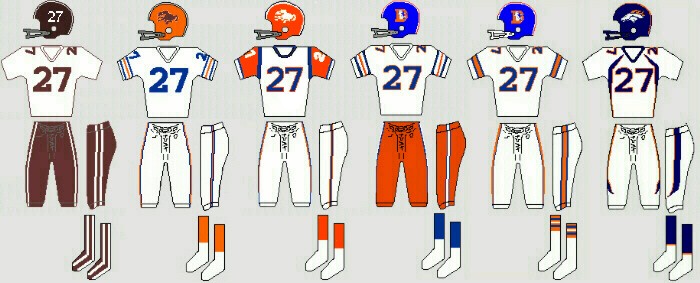
ESC's Game-Used News
ARCHIVE

This page features archived articles and information from Endzone's Game-Used News page


 2010 Quick Hits (1/2/11)
2010 Quick Hits (1/2/11)  Broncos “White” at Home (5/6/10) For 1957, three years before the formation of the American Football League’s Denver Broncos, the NFL instituted a uniform rule stipulating a standardized policy for teams to wear dark uniform jerseys when playing at home and white (or light) jerseys when on the road at their opponents’ field. Subsequent rule changes have provided some flexibility to this policy. While a majority of teams still adhere to this convention, current rules essentially allow the home team to elect their choice as to wearing either light of dark colored jerseys. Many warm-climate teams such as the Chargers and Dolphins, elect to wear lighter colored jerseys at home, particularly during the warmer weather of the first two months of a season.
Throughout their history, the Broncos have mostly maintained this standard white/away dark at home convention regarding jersey selection. Even during the penny-pinching early days of 1960-’61, they embraced this in spirit when light gold jerseys were worn as a part of the home uniform and white jerseys were worn on the road. There have, however, been exceptions during the past fifty years—some forced by the choice of the home team; others as the result of accidental “wardrobe malfunction”.
Broncos “White” at Home (5/6/10) For 1957, three years before the formation of the American Football League’s Denver Broncos, the NFL instituted a uniform rule stipulating a standardized policy for teams to wear dark uniform jerseys when playing at home and white (or light) jerseys when on the road at their opponents’ field. Subsequent rule changes have provided some flexibility to this policy. While a majority of teams still adhere to this convention, current rules essentially allow the home team to elect their choice as to wearing either light of dark colored jerseys. Many warm-climate teams such as the Chargers and Dolphins, elect to wear lighter colored jerseys at home, particularly during the warmer weather of the first two months of a season.
Throughout their history, the Broncos have mostly maintained this standard white/away dark at home convention regarding jersey selection. Even during the penny-pinching early days of 1960-’61, they embraced this in spirit when light gold jerseys were worn as a part of the home uniform and white jerseys were worn on the road. There have, however, been exceptions during the past fifty years—some forced by the choice of the home team; others as the result of accidental “wardrobe malfunction”.
Below are identified instances over the past four decades where the Broncos have deviated from the standard home/road convention or worn alternate uniforms:
 Brisk Sales of Broncos Jersey Close Out 2009 (1/9/10) After a bright start to what was expected to be a rebuilding season, sales of Broncos jerseys/uniforms peaked from the period of September to December of 2009, notching over fifty sales transactions during this period (see summary of ‘Recent Sales’ below). While interest in football-related memorabilia is typically higher during the playing season, 2009 has yielded noticeably more sales when compared to the same period of years past.
Brisk Sales of Broncos Jersey Close Out 2009 (1/9/10) After a bright start to what was expected to be a rebuilding season, sales of Broncos jerseys/uniforms peaked from the period of September to December of 2009, notching over fifty sales transactions during this period (see summary of ‘Recent Sales’ below). While interest in football-related memorabilia is typically higher during the playing season, 2009 has yielded noticeably more sales when compared to the same period of years past.
While venues such as the online marketplace eBay and auctions houses including American Memorabilia and Grey Flannel were contributors as always, one new source and another old standby were responsible for most of this past years’ volume increase.
NFL Auction (www.nflauction.nfl.com), which offers memorabilia sourced directly from either the participating teams or the league, made its presence felt in offering nearly the entire team’s roster of game-worn “AFL Legacy” road jerseys worn durring the October 19th game played at San Diego. Offered under the umbrella of the “NFL Play 60”movement—the league’s initiative to make the next generation the most active and healthy—all proceeds from the auctions were to go to the program’s partners who each work in their own way to get children active for 60 minutes each day in order to fight the epidemic of childhood obesity.
Nearly two dozen jerseys were offered over a period of November and December with prices ranging from a low of $255 for the road “Legacy” jersey of Josh Barrett to a high of $2,040 for a similarly-styled jersey worn by rookie running back Knowshow Moreno.
New to the scene this year was JO Sports Co., Inc. (www.josportsco.com). Established in 2003, the Las Vegas (NV) based dealer entered 2009 with the first of a multi-year marketing deal with the Denver Broncos, which would bring Broncos game-worn/used items to the marketplace, having been sourced directly from the team. The company’s initial inventory consisted of a nice selection of complete uniforms (jersey, pants and socks) from the October 11th “AFL Legacy” game vs. the ‘Boston’ Patriots. Recent inventory additions include a sampling of navy home jerseys from the November 26th Thanksgiving Day game vs. the New York Giants as well as a few from the November 22nd game vs. the Chargers.
With straight-from-the-field authenticity being guaranteed, premium pricing for these rare pieces was typical, however, as of mid-December, several items, which had been in inventory for a number of weeks, were deeply discounted; some by up to 50% off of initial asking prices. Topping their offerings was the complete unifrom of rookie RB Knowshon Moreno , which was initially listed at $5,000 , however, neither the actual sale price, or whether or not this sale was actually consumated cannot be confirmed. At the low end of the scale are a small sampling of players whose jerseys are listed at $750 each (Fields, McBean & Peterson).
According to JO Sports Co. president Jarrrod Oldridge, there are still a very limited number of high-profile player’s jerseys yet to be added to inventory from this past season. Oldridge added, “We strive to (be) the place to go for all of your game worn Bronco’s game used memorabilia”.
eBay continues to be venue of choice for lower-valued itmes. Some of these are simply jerseys of either the lesser known, non-rostered, or exhibition season only players or jerseys while others come with scant evidence of on-the-field wear and/or somwhat dubious claims as to provenance. Despite this reputation, an occassional gem or two pops to the surface there. Two Broncos jerseys, one each home and road, dating from the 1962-’64 period, were offered in early October. The orange home jersey displayed obvious signs of wear and may possibly have been worn by either defensive backs Bob Zeman (1962-’63), Norman Bass (1964) or halfback John Griffin (1964-’66). The white road jersey displayed neither signifcant signs of use nor evidence of the application of a nameplate. Though worn or not, it is still believed to have at least been team-issued during the period. Both jerseys were sourced from the same seller and both were purchased by the same buyer, reportedly a noted collector of AFL memorabilia.
 Looking back… Random Observations of the 50th Anniversary Season (1/9/10)
Looking back… Random Observations of the 50th Anniversary Season (1/9/10)
 Grey Flannel Auctions teams up with NFL Alumni (1/9/10) The NFL Alumni has chosen Grey Flannel Auctions, a purchaser and auctioneer of sports memorabilia, to assist former NFL players with the sale and marketing of their personal items and entire collections.
Grey Flannel Auctions teams up with NFL Alumni (1/9/10) The NFL Alumni has chosen Grey Flannel Auctions, a purchaser and auctioneer of sports memorabilia, to assist former NFL players with the sale and marketing of their personal items and entire collections.
Grey Flannel will present Alumni members and former players an opportunity for extra income through the sale of their game-used jerseys, helmets, Championship rings, trophies, autographed items, etc.
For the past two decades, Grey Flannel has been the official appraisers for the Naismith Memorial Basketball Hall of Fame. In addition, for the past six years, they hav assisted the Major League Baseball Players Alumni Association (MLBPAA) and its members in a similar capacity, offering free appraisials on the keepsakes and treasures accumulated throughout their playing careers.
Grey Flannel representatives will be traveling around the county offering retired NFL players free appraisals. Recently, complimentary appraisals took place in Baltimore, MD and Atlantic City, NJ. The next ones will be offered in Miami during the week leading up to Super Bowl XLIV.
Source: NFLA Pro Legends, December 2009, Vol 11, No. 6, p. 2
 Varied Uni Styles Abound in ‘09 (9/7/09) With the Broncos kicking off their 50th anniversary season, the 2009 season will present the greatest variety of uniform styles in the team’s history. In a season marked by “AFL Legacy” celebrations throughout the league, the Broncos will hit the field in four unique uniform combinations, with five different jerseys to be worn.
Varied Uni Styles Abound in ‘09 (9/7/09) With the Broncos kicking off their 50th anniversary season, the 2009 season will present the greatest variety of uniform styles in the team’s history. In a season marked by “AFL Legacy” celebrations throughout the league, the Broncos will hit the field in four unique uniform combinations, with five different jerseys to be worn.
Based on observations of pre-season action, little change is anticipated for the team’s standard uniform. Save for the addition of the team’s 50th anniversary patch to be affixed to the left chest of the jerseys, the navy and orange home jerseys (along with white pants sporting orange striping) and the white and navy road jerseys (matched with white pants with navy striping), remain materially unchanged.
Making their fourth season’s appearance, the orange “alternate” jerseys, first introduced in 2002 and also used in 2004 & 2008, will be worn for two additional games during the upcoming season. The Broncos will again roll out the orange tops (worn along with traditional “road” pants) while hosting the Dallas Cowboys on October 4 and the Pittsburgh Steelers on November 9.
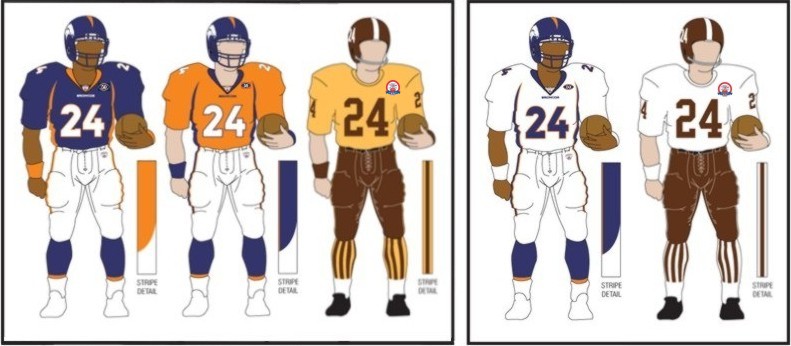
During back-to-back weekends in October, the Broncos will celebrate the “AFL Legacy”, donning modern uniforms patterned after the teams’ original hand-me-down duds from 1960. In the home game on October 11, the team will host the New England (Boston) Patriots decked out in gold and brown uniforms, complete with brown, numbered helmets and the notorious vertically-striped socks. The following week, the team travels to San Diego to play the Chargers on the 19th; where they will wear the white and brown “road” version of the 1960-’61 unis. The team indicated that it was also investigating the possibility of wearing the gold/brown home “throwback” uniforms for one additional game, however, confirmation was not possible at the time of publication.
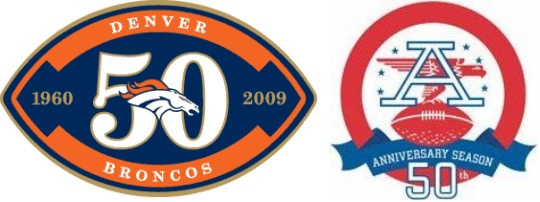
To commemorate the 50th anniversary season, two distinctly different commemorative patches (see above) will be affixed to the upper left chest of the team’s 2009 uniform jerseys. Current style jerseys (including orange “home” alternate) will be adorned with the unique Broncos 50th anniversary logo patch. Orange, navy blue, white and gold in color, the logo features the current horse-head logo superimposed over the number ‘50’. The words “Denver” and “Broncos” appear above and below, respectively, with the years ‘1960’ to the left and ‘2009’ to the right. During the two (or possibly three) occasions when the team dons its 1960-styled “AFL Legacy” uniforms, the jerseys will have the AFL 50th anniversary logo patch affixed. This patch will be worn by all former AFL teams on their respective AFL Legacy jerseys and is an adaptation of the original AFL logo with annotation regarding the “50th Anniversary Season”.
 JO Sports Co. to Offer Broncos Gamers (9/7/09) JO Sports Co., Inc., a leader in bringing authentic game-used and autographed pro sports memorabilia to collectors, has reached an agreement to become official partners with the Denver Broncos. The company will now be the exclusive provider of game-used equipment sourced directly from the team.
JO Sports Co. to Offer Broncos Gamers (9/7/09) JO Sports Co., Inc., a leader in bringing authentic game-used and autographed pro sports memorabilia to collectors, has reached an agreement to become official partners with the Denver Broncos. The company will now be the exclusive provider of game-used equipment sourced directly from the team.
The marketing agreement includes the distribution of game-worn jerseys, pants, helmets, sideline apparel, game-used footballs and other authentic memorabilia for the Broncos. It offers collectors and fans the opportunity to purchase highly sought-after and very personal NFL gear directly from a legitimate source, with ironclad provenance.
Established in 2003, JO Sports Co. currently has existing marketing agreements with the Chicago Bears, Minnesota Vikings and Oakland Raiders. In addition to the Broncos, other new teams added to the stable for 2009 are the New York Jets and San Diego Chargers. JO Sports Co. also has non-marketing agreements which allow the company to purchase and re-sell game-used memorabilia from the Washington Redskins, New Orleans Saints, Tennessee Titans, Jacksonville Jaguars and Atlanta Falcons. Along with its growing number of teams, the company also has over a dozen exclusive player contracts for game-worn and autographed memorabilia.
All game-used items will be secured by the team’s equipment staff, then tagged and shipped to JO Sports’ Las Vegas office where they will be photo-matched to the specific game in which they were utilized. All will come with a letter of authenticity from the team. Game-worn items will have the company’s revolutionary ThermoPatch applied to the inside. The patch is virtually impossible to remove and indicates the player, date worn and opponent. Each piece is then certified with a serial-numbered hologram, which is entered into JO Sports’ database.
“We are in the process of taking our JOSportsCo.com verification online,” said company president Jarrod Oldridge. “With this procedure, the collector can enter the serial number on each LOA to verify his or her item. At this point, we send each piece of memorabilia to our in-house photography studio. Once the collectible is photographed, it is again bagged and ready for sale.”
The agreements mean JO Sports Co. will be receiving some of the special 2009 AFL Legacy game jerseys and helmets from theBroncos, Jets, Chargers and Raiders and offering them for sale later this fall. They will also have the first game-used items from Broncos’ rookie Knowshon Moreno. Nearly all jerseys and equipment will be unwashed, allowing collectors to do their own photo matching via grass and blood stains, along with helmet and hit marks.
“It’s one thing to have a piece of memorabilia with a letter of authenticity but it is another to have that same piece of memorabilia with the LOA and a photo of the item being worn with matching marks,” said Oldridge.
The game-used items will be sold exclusively on the JO Sports Co., Inc. website at www.josportsco.com
 NFL To Celebrate 50th Anniversary of AFL (5/2/09) The 2009 NFL season marks the 50th anniversary for the eight teams that played in American Football League, and plans to celebrate that benchmark were announced in March at the NFL Annual Meeting in Dana Point, CA.
NFL To Celebrate 50th Anniversary of AFL (5/2/09) The 2009 NFL season marks the 50th anniversary for the eight teams that played in American Football League, and plans to celebrate that benchmark were announced in March at the NFL Annual Meeting in Dana Point, CA.
The American Football League, which merged with the NFL in 1970, played its first season in 1960 with eight teams. They were the Buffalo Bills, Denver Broncos, Dallas Texans (Kansas City Chiefs), Boson (New England) Patriots, Titans of New York (Jets), Oakland Raiders, Los Angeles (San Diego) Chargers and the Houston Oilers (Tennessee Titans).
The NFL will highlight the 50th anniversary of those teams during "Legacy Games" throughout the 2009 season. During one home and one road game, former AFL teams will meet head-to-head while wearing their chosen historic uniforms.
The Broncos will sport uniforms patterned after the team’s look of 1960-’61, replete with vertically stripped stockings. The 2009 team will don the mustard and brown home uniforms on October 11 for their game with the New England Patriots (during which, the team’s 50th Anniversary Team will be announced). The following week, the Broncos will travel to San Diego to take on their division rival Chargers, wearing their brown and white road uniforms. Though unconfirmed, it is our understanding that the team is also negotiating with the league to possibly wear one of these two uniforms for a third game during the season as well.
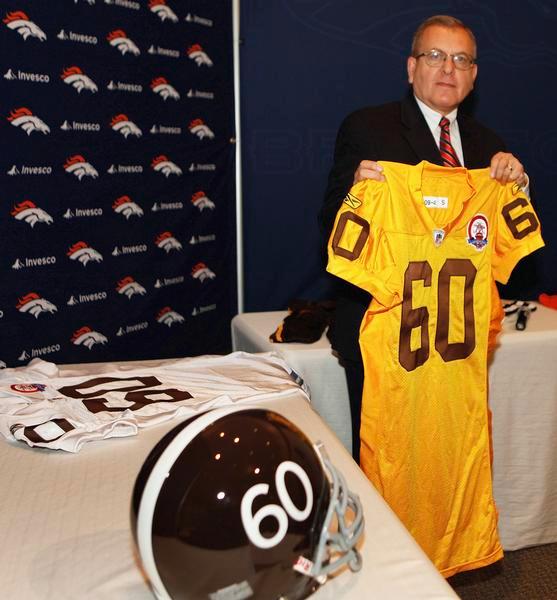
The NFL and the eight former AFL teams are planning to celebrate the 50th anniversary season with numerous events throughout the season. Additionally, the NFL Network, NFL.com and NFL Films will commemorate this anniversary with unique content and programming highlighting the history of the AFL and the original eight teams.
Game-worn jerseys and signed memorabilia will be auctioned at NFL Auctions throughout the season, with the money raised going to the NFL Player Care Foundation. It is our understanding that the Broncos road white/brown "throwback" jerseys will be made available through this outlet.
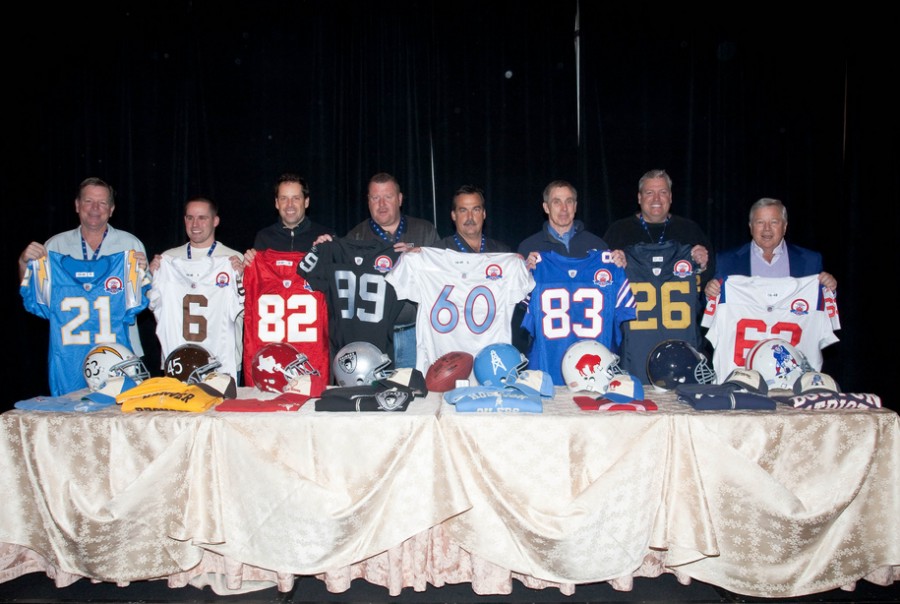
Below is a list of what each of the other original AFL teams will wear as their historic uniforms during the 2009 season:
 Helmet Specs… The Sixties (5/2/09) While the Broncos’ uniforms of the early AFL days are most noted because of their infamous leggings, the helmets from this first decade were the most varied of any 10-year period in the teams’ history. From the simplistic design utilized by the inaugural 1960 team to the enduring and iconic royal blue style first introduced in 1968, over a half-dozen distinct styles found their way onto the heads of the Broncos players of the sixties.
Helmet Specs… The Sixties (5/2/09) While the Broncos’ uniforms of the early AFL days are most noted because of their infamous leggings, the helmets from this first decade were the most varied of any 10-year period in the teams’ history. From the simplistic design utilized by the inaugural 1960 team to the enduring and iconic royal blue style first introduced in 1968, over a half-dozen distinct styles found their way onto the heads of the Broncos players of the sixties.
For the most part, the Broncos organization assembled a rag-tag group of NFL has-beens, Canadian exports, and college wannabes in order to field their first team in 1960. There uniforms mirrored the shoestring budget mentality as used brown, gold and white attire was provided by General Manager Dean Griffing, complete with the dreaded vertically-striped hosiery.
The player’s helmets, however, were said to have been purchased new. These were painted a solid dark-brown color with a white, 1” center stripe added. In lieu of a team logo, the player’s uniform number adorned each side of the helmet in a 3” white sans serif font. Riddell, the Broncos’ predominate supplier of helmets during the AFL-era, essentially offered two helmet styles in 1960, the RK-4 and the TK-5.

The RK-4 was first introduced in 1954 and featured a 3-piece Kra-Lite® ABS shell which was slightly flared at the ear. Ventilation was provided via a series of 32 holes in the shell. The helmet’s suspension consisted of a leather-crowned, 3-loop, 6-point nylon-cotton webbing that was affixed to the shell via rivets. Leather jaw pads were also riveted into the shell.
The TK-5, introduced a year later in 1955, featured a similar suspension with a rubber crown. This was bound inside a rounded, one-piece TruKurv ABS shell with four ventilation holes. The jaw pads were now temporarily affixed with snaps, to accommodate ease of replacement and a grey snubber was added to the front of the helmet’s shell, providing additional protection for the bridge of the nose. The “TK” style shell came about with the newest technology of the day, whereas collapsible cores allowed now allowed for the oddly shaped shells to be formed in single-piece fashion. Elimination the sharp edges associated with the sectional shells, the one-piece shell could be considered as one of the greatest developments in the evolution of the football helmet. Both the TK-5 model, as well as the RK-4, would continue to be offered through 1966.
In 1961, while the aesthetic appearance of the Broncos’ helmets remained unchanged, Riddell introduced a third model to their offering. The RK-2 sported a flared 3-piece Kra-Lite® ABS shell with 6-hole ventilation. The suspension of this new model was reinforced, utilizing a riveted 6-loop, 12-point webbing with a rubber crown. Snap in jaw pads and a grey snubber were also featured.
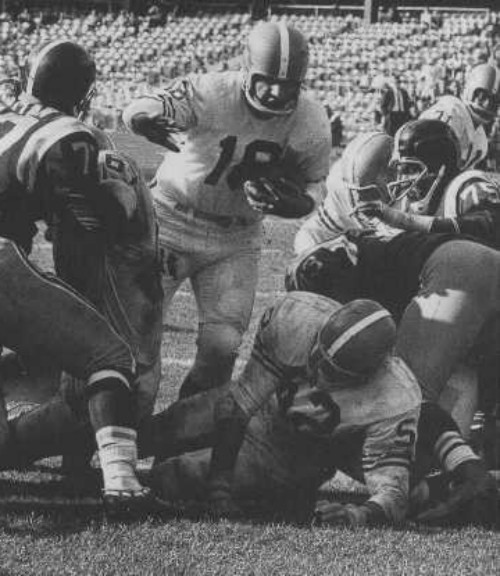
For 1962, new head coach and general manager Jack Faulkner, felt that a new image was appropriate for the struggling team. At Faulkner’s request, Bob Bowie of the Denver Post designed the logo and general concept for the teams new uniforms incorporating the color orange for the first time in the team’s history. The new helmet would be painted a solid “cream-sickle” orange, with a 1” white center stripe added. The logo was a cartoon-ish bucking bronco, and was originally brown in color, the only color carry-over from the 1960-’61 seasons. Very quickly, it was recognized that the brown logo was not clearly visible due to the limited contrast between the brown and the orange helmet shell. By the sixth game of the season, the brown logos had been replaced by the more familiar white logo. Also in 1962, Riddell would begin offering what would become one of the era’s more popular and enduring models, the TK-2.
The TK-2 was initially fitted with a 1-piece polycarbonate rounded shell; however, by 1963 the experimental shell was replaced with one of ABS construction. The polycarbonate material was found to become so imbrittled in the presence of lacquer solvents and many detergents that nearly all of the strength properties were lost. With four ventilation holes, snap-in jaw pads and grey snubber, suspension was provided via 6-loop, 12-point riveted webbing with a rubber crown. This popular model would continue to be offered by Riddell in various configurations until 1978. The RAC-H2, introduced in 1965, and later the RAC-H8 were essentially the same shell with variations of updated Aero-Cell suspensions. In 1965, uniform numbering reappeared on the players’ helmets, in the form of white 2” NCAA style sans-serif numerals, placed at the rear of the helmet, straddling the center line.
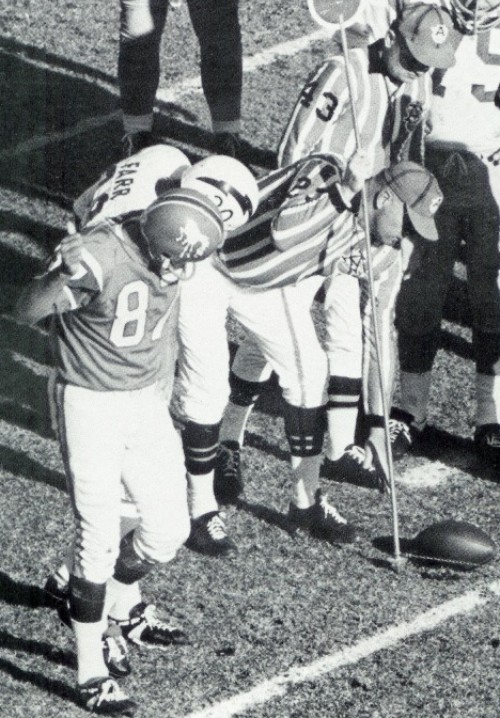
In 1966 the aesthetic styling of the helmet was updated slightly, resulting in a 1-year style. While the shell’s orange base color and single-color logo remained the same as its 1962-’65 predecessor, the center striping configuration was altered slightly, with the single white stripe being replaced by a 1” royal blue center, bordered by dual 3/4" white stripes.
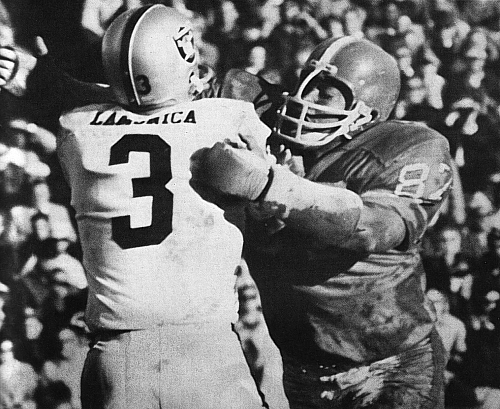
The 1967 season saw the team bringing in new coach/GM Lou Saban who revamped the entire uniform, including the helmet. The “orange crush” style uniform would, with periodic, minor cosmetic updates, become the standard uniform for the team for the next three decades. The helmet, however, would take one additional season before developing fully, resulting in yet another one-year style. For this season, the grey shells were to be painted a dark royal blue. The 1” center stripe would be white; bordered by dual 3/4" stripes, which were a reddish, dark orange. Missing from this helmet was the team logo, which was not to be finalized until later in the year, and not added to the helmets until the following year.
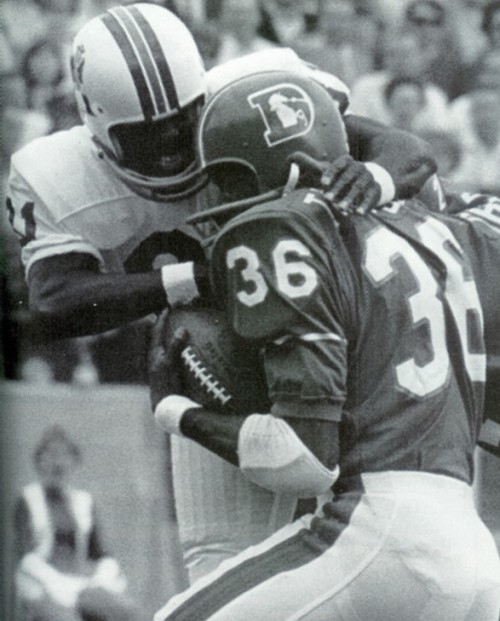
In 1968, the royal blue painted shells would have 1967’s stripping patter reversed, with a reddish orange 1” center stripe now being flanked by dual, white 3/4" outer stripes. Additionally, 1968 would see the first use of the “D” logo with a white snorting bronco rearing from the center of a bold orange “D”. Likely the most identifiable logo to be associated with the team, it would remain in place through 1996.
 Mingo Receives AFL Alum Ring (1/17/09) Gene Mingo remains perplexed and as to why his on-the-field accomplishments during his pro football career have not been more widely recognized. For his 10-year career—four and a half with the Broncos—the formal acknowledgment has often eluded him. And while he remains waiting for the Ring of Fame to come calling, a less formal recognition served as a reminder that some do indeed recognize the efforts of some of the games’ early pioneers.
Mingo Receives AFL Alum Ring (1/17/09) Gene Mingo remains perplexed and as to why his on-the-field accomplishments during his pro football career have not been more widely recognized. For his 10-year career—four and a half with the Broncos—the formal acknowledgment has often eluded him. And while he remains waiting for the Ring of Fame to come calling, a less formal recognition served as a reminder that some do indeed recognize the efforts of some of the games’ early pioneers.
This past August, Tom Jacobsen, associate director of Endzone Sports Charities (ESC), met with Mingo to present him with an American Football League (AFL) Alumni ring, in thanks for his years of service to the AFL and more importantly to the Broncos organization and its fans.
Jacobsen’s parents (whose first date was to a Broncos game in the 1960 inaugural season) bought season tickets following the 1967 season ticket campaign and his family has attended every home game since, regardless of the weather. Tom reminisces that “many of my fondest memories, as well as those of my immediate and extended family, have a Broncos game somehow in the mix. In reflecting on all of the good times and memories that we experienced through the Broncos, I thought it would be great to find a way to give back to one of the folks that made it all possible.”
When Jacobsen became aware of the AFL Alumni rings, “I immediately thought this could be the perfect opportunity.” Put in touch with Gene, he instantly knew that Mingo was the perfect choice. “Gene’s unbelievable athleticism, his toughness and his passion made him one of the best and most important players from those first Broncos teams. After having a chance to meet with Gene personally, hear his life story as well as the great tales of his playing days, I and my family were incredibly honored to be able to give this ring to Gene and say ‘Thank You’”.
Thrilled with the ring, Gene commented, that he “(finds) it very hard to put into words my gratitude and appreciation to the Jacobsen family for purchasing me the exquisite memorable AFL Ring. I never dreamt that I would have the opportunity to wear this ring. I am not only proud but overjoyed to own it.” Mingo went on to express his deepest thanks to the Jacobsen family for sharing their long-standing support of the Denver Broncos by honoring him and presenting him with this gift. “They are true and loyal fans”, said Gene.
The ring was produced by Herff Jones—a world-renowned maker of high-quality high school, college and professional championship rings (including Super Bowl rings)—they retain some of the dies used for some of the original AFL rings produced in the 1960s. On the face of the ring is a simulated stone set above the letters “AFL” and surrounded by “AMERICAN FOOTBALL LEAGUE ALUMNI” in raised block lettering. One side has a relief of a football gridiron above a 'ribbon' with the team name. Below this is a football helmet in relief above a second ribbon with the player’s name. The opposite side has a relief of the American Football League logo.
Made available through the efforts of Ange Coniglio—a long-time supporter of the AFL and creator of the RememberTheAFL web site, Ange has paid the upfront costs in order to make these rings available to both AFL alumni and fans. If ring sales generate more than the costs paid, all excess funds will be sent in the name of AFL players and fans, to the Gridiron Greats Assistance Fund, with the stipulation that the funds be used to help a retired AFL players in need. Says Coniglio, “I neither want nor will I accept any profit from the sale of these rings.”
If you're interested in obtaining on of these yourself, more information is available at http://www.remembertheafl.com/AFLRing.htm including a printable ring order form, which can be sent directly to Herff Jones, along with appropriate payment (approximate costs range from $350 to $840, depending upon metal chosen).
ESC hopes to make the presentation of one of these rings a regular occurrence, selecting a deserving former Bronco to whom one of these rings will be presented each year.
 Little Jersey at Auction Aids Style ID (1/2/09) A 1967-’68 style Broncos’ jersey was recently offered by American Memorabilia, Inc. of Las Vegas, Nevada during their auction which ended September 18. The rare Durene home jersey worn by Floyd “The Franchise” Little commanded an astounding winning bid of $18,863, including the 20% buyer’s premium.
Little Jersey at Auction Aids Style ID (1/2/09) A 1967-’68 style Broncos’ jersey was recently offered by American Memorabilia, Inc. of Las Vegas, Nevada during their auction which ended September 18. The rare Durene home jersey worn by Floyd “The Franchise” Little commanded an astounding winning bid of $18,863, including the 20% buyer’s premium.
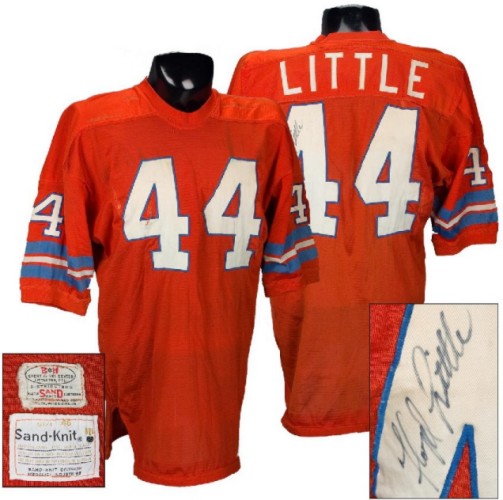
While a team-restored nameplate was this piece’s only detractor (and a minor one at that), of particular interest to ESC and other uniform historians was the presence of the never before seen tail tagging, positively identifying this era’s uniforms as having been supplied by Sand-Knit, a division of Medalist Industries.
Two previous exemplars of this style has been previously examined--home gamers of QB Steve Tensi, which we had the privilege of examining first-hand, and a war-torn jersey of Rich ‘Tombstone’ Jackson, which was uncovered and purchased by Endzone Sports Charities (ESC). In addition to missing the sewn-on nameplates, which were commonly recycled by the team, the manufacturer’s tail tagging was also missing on both, having long worn away from the underlying material. All that remained was the faint stitching marks from where the original tagging had once been affixed. Physical examination of these tag-less jerseys, along with supporting photo documentation had previously led to speculation that the early Duren jerseys of the “orange crush” style had been manufactured by Wilson Sporting Goods.
Unlike these previously examined samples, however, the recently-surfaced Little jersey had the distinction of retaining the original tail tagging. This included both the manufacturer’s size/laundering instructions tagging and, just above this was the identifier of the local sporting goods distributor, B&H Sport & Ski Center of Littleton, Colorado, from whom they were purchased. The “Sand-Knit” manufacturer’s tagging features the numeric sizing indicator in gold font centered at the top of the tag; below this is the Sand-Knit® name (black) and Medalist’s logo (black medal below gold ribbon). Below are three lines of laundering instruction in gold font with black underlining. Centered at the bottom of the label is the black text, “Sand-Knit Division” just above “Medalist Industries”. The separate and smaller distributor’s tag is located just above.
 Numbers Game (1/2/09) In team sports, including professional football, the jersey number or uniform number is the number worn on the player’s uniform for the purpose of player and position identification. This number is typically displayed on the rear of the jersey, accompanied by the player’s surname and if necessary the player’s first name initial or, in rarer cases, the entire first name. Though slight variation in size exists, the rear number typically averages about 12” in height. The number is also displayed, usually in a slightly smaller font size (averaging about 10” in height) on the front of the jersey. Modern NFL jerseys will also feature “TV” numbers of approximately 4” height applied to the jersey’s sleeves or shoulders. These numbers are used to identify the player to officials, other players, and official scorers. In the NFL, the uniform numbers are also indicative of the player's position.
Numbers Game (1/2/09) In team sports, including professional football, the jersey number or uniform number is the number worn on the player’s uniform for the purpose of player and position identification. This number is typically displayed on the rear of the jersey, accompanied by the player’s surname and if necessary the player’s first name initial or, in rarer cases, the entire first name. Though slight variation in size exists, the rear number typically averages about 12” in height. The number is also displayed, usually in a slightly smaller font size (averaging about 10” in height) on the front of the jersey. Modern NFL jerseys will also feature “TV” numbers of approximately 4” height applied to the jersey’s sleeves or shoulders. These numbers are used to identify the player to officials, other players, and official scorers. In the NFL, the uniform numbers are also indicative of the player's position.
In 1952 the NFL initiated a system of assignment of jersey numbers; in 1973 this was updated and made more rigid. Most NFL also feature the uniform number displayed on the players’ helmets, typically on the back, however, the Pittsburgh Steelers historically have placed these numbers on the front, while others, such as the 1960-’61 Broncos featured the numbers predominately on the helmets’ sides.
Below is the numbering system established by the NFL, and in place since 1973:
It should be noted that this numbering system is based on a player's primary position. Any player wearing any number may play at any position on the field at any time, however, players wearing numbers 50 through 79 must let the referee know that they are playing out of position by reporting as an “ineligible number in an eligible position”. It is not uncommon for running backs to line up at wide receiver on certain plays, or to have a lineman play at fullback or tight end in short yardage situations. Also, in preseason games, when teams have expanded rosters, players may wear numbers that are outside of the above rules. When the final 53-player roster is established, they are reissued numbers within the above guidelines.
Regarding the history of the Broncos uniform numbers…
 NFL players to wear patch honoring Upshaw (Updated: 9/15/08) NFL players will wear a uniform patch this season to honor NFL Players' Association leader Gene Upshaw, who died Aug. 20. Upshaw died of pancreatic cancer just three days after he was diagnosed.
NFL players to wear patch honoring Upshaw (Updated: 9/15/08) NFL players will wear a uniform patch this season to honor NFL Players' Association leader Gene Upshaw, who died Aug. 20. Upshaw died of pancreatic cancer just three days after he was diagnosed.
The league announced Monday that the patch will have the initials GU and the number 63, which he wore while playing for the Oakland Raiders. The patch will be worn on the left chest of jerseys and is scheduled to make its debut Thursday, when the New York Giants and Washington Redskins open the season. Upshaw's wife, Terri, and his three sons will participate in the coin toss.
The Raiders also will honor Upshaw in their opening game on Sept. 8 with a video tribute, and a replica of the uniform patch will be painted on the field in Oakland and at the Meadowlands.
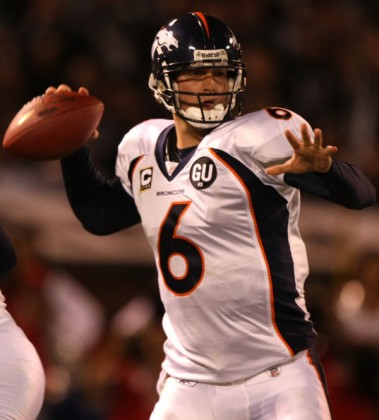
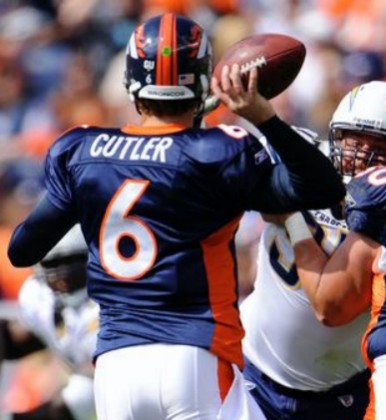
Update [The following information has been updated from the previous information, originally posted on 9/2/08]: Originally it was stated that, “NFL players will wear a uniform patch this season to honor... Gene Upshaw”, implying that said patch would be worn the entire season. The patch, sewn on the left chest between the jersey’s collar and striping, was worn for the first game only, on Monday, September 8, 2008. For the Week 2 game, in lieu of the jersey patch, a smaller, similarly styled decal was applied to the left side of the team’s helmets, immediately above the uniform number decal
 Tales of Retail Sales (8/31/08) Today, for generally under about $250, any NFL fan can log on to one of the scores of web sites and order a customized Reebok “Authentic” jersey. Within a short period of time, the fan is delivered a very close approximation of the professional-quality jerseys worn by players on the field. Knowledgeable collectors and uniform historians, however, can still readily point out the differences between the on-field apparel worn by the pros and the high-quality retail offerings.
Making this comparison in the present is relatively easy in that having both jerseys for a side-by-side evaluation, either physically or virtually, is quite achievable. When the topic turns to vintage retail jerseys, however, both the relative scarcity of such jerseys as well as the availability of comparable on-field jerseys makes comparisons difficult, if not impossible. This is one of the reasons that vintage retail jersey are, on occasion, incorrectly offered and passed off in the collectibles hobby as game jerseys.
As early as the mid-1970s, mail-order retailers advertising in the sports-related periodicals of the era were offering “official team jerseys”. Though a far cry from the quality of the on-field jerseys, such ads serve to point out that the NFL has been licensing and marketing player-based consumer apparel for well over thirty years.
By the late 1970s, the Broncos had been to their first Super Bowl, riding the crest of the wave that was the “Orange Crush”. They did so donning the bright orange nylon mesh jerseys from Russell Athletic. While the team’s jerseys of this period were distinctly Denver Broncos, the design and construction was fairly simplistic compared to the mixed high-tech fabrics and elaborate styling of today’s modern jerseys. Because of this rather straightforward design and construction, the pro-quality jerseys were fairly easily reproduced for mass marketing to the public. An advertisement in the 1977 Street & Smith’s Pro Football Annual offered customizable (any name and uniform number) “professional style, quality, authentic game jerseys”. No mention of manufacturer was made in the ad, and the jerseys were offered in a “full size range—S, M, L, XL, XXL”.
Tales of Retail Sales (8/31/08) Today, for generally under about $250, any NFL fan can log on to one of the scores of web sites and order a customized Reebok “Authentic” jersey. Within a short period of time, the fan is delivered a very close approximation of the professional-quality jerseys worn by players on the field. Knowledgeable collectors and uniform historians, however, can still readily point out the differences between the on-field apparel worn by the pros and the high-quality retail offerings.
Making this comparison in the present is relatively easy in that having both jerseys for a side-by-side evaluation, either physically or virtually, is quite achievable. When the topic turns to vintage retail jerseys, however, both the relative scarcity of such jerseys as well as the availability of comparable on-field jerseys makes comparisons difficult, if not impossible. This is one of the reasons that vintage retail jersey are, on occasion, incorrectly offered and passed off in the collectibles hobby as game jerseys.
As early as the mid-1970s, mail-order retailers advertising in the sports-related periodicals of the era were offering “official team jerseys”. Though a far cry from the quality of the on-field jerseys, such ads serve to point out that the NFL has been licensing and marketing player-based consumer apparel for well over thirty years.
By the late 1970s, the Broncos had been to their first Super Bowl, riding the crest of the wave that was the “Orange Crush”. They did so donning the bright orange nylon mesh jerseys from Russell Athletic. While the team’s jerseys of this period were distinctly Denver Broncos, the design and construction was fairly simplistic compared to the mixed high-tech fabrics and elaborate styling of today’s modern jerseys. Because of this rather straightforward design and construction, the pro-quality jerseys were fairly easily reproduced for mass marketing to the public. An advertisement in the 1977 Street & Smith’s Pro Football Annual offered customizable (any name and uniform number) “professional style, quality, authentic game jerseys”. No mention of manufacturer was made in the ad, and the jerseys were offered in a “full size range—S, M, L, XL, XXL”.
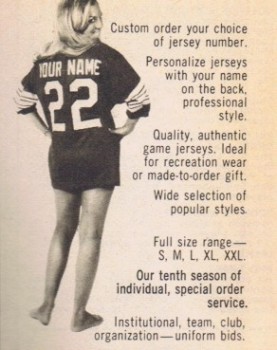
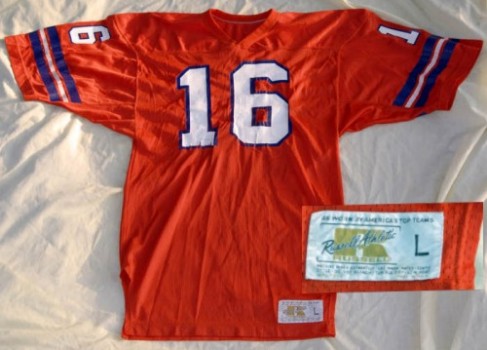
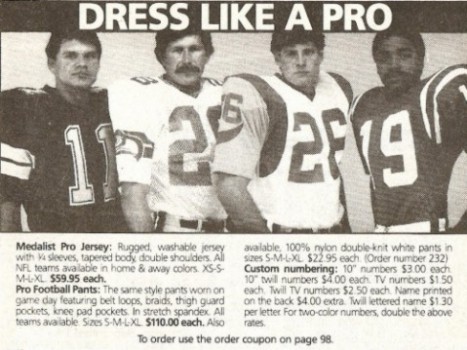
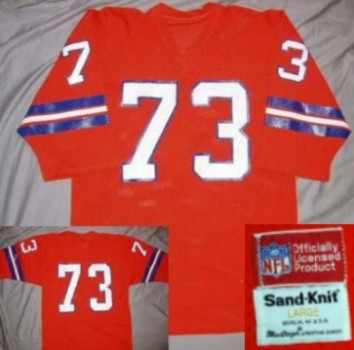
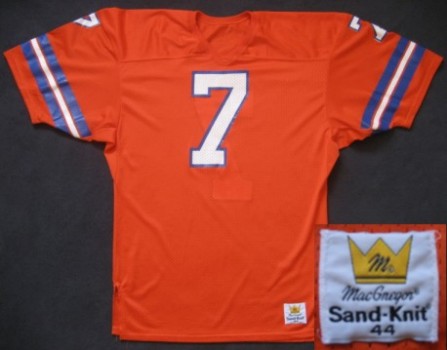
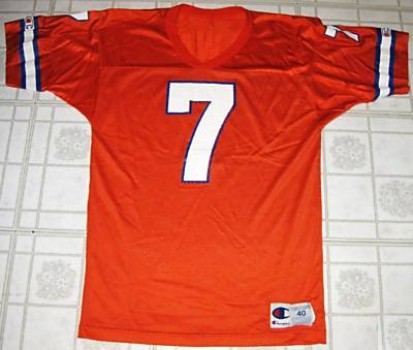
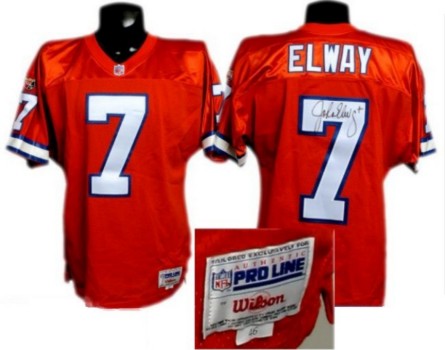
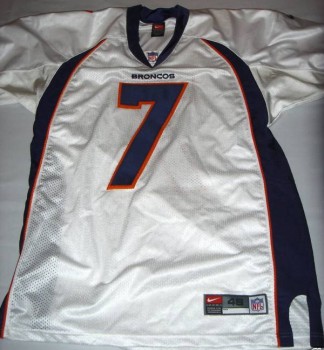
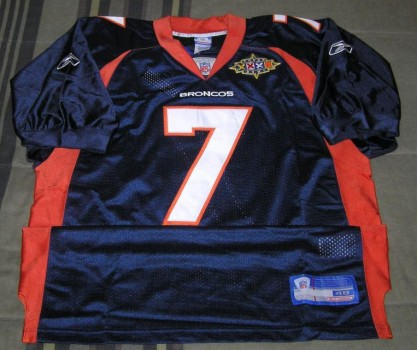
 ESC Displays at 2008 Fan Fair (8/31/08) For the second consecutive year, Endzone Sports Charities was honored to participate in the Denver Broncos’ Fan Fair event held at INVESCO Field on June 7-8. Appearing in the Broncos’ Museum, Tom Jacobsen and I were once again on hand to display ESC’s Ring of Fame jersey and memorabilia collection, which features actual game jerseys representing the evolution of the team’s uniforms across five decades as worn by many of the team’s greatest players including Frank Tripucka, Rich Jackson, Jim Turner, Floyd Little, Charley Johnson, Louis Wright, Craig Morton, John Elway, Dennis Smith, Steve Atwater, and newest Hall of Famer Gary Zimmerman.
ESC Displays at 2008 Fan Fair (8/31/08) For the second consecutive year, Endzone Sports Charities was honored to participate in the Denver Broncos’ Fan Fair event held at INVESCO Field on June 7-8. Appearing in the Broncos’ Museum, Tom Jacobsen and I were once again on hand to display ESC’s Ring of Fame jersey and memorabilia collection, which features actual game jerseys representing the evolution of the team’s uniforms across five decades as worn by many of the team’s greatest players including Frank Tripucka, Rich Jackson, Jim Turner, Floyd Little, Charley Johnson, Louis Wright, Craig Morton, John Elway, Dennis Smith, Steve Atwater, and newest Hall of Famer Gary Zimmerman.
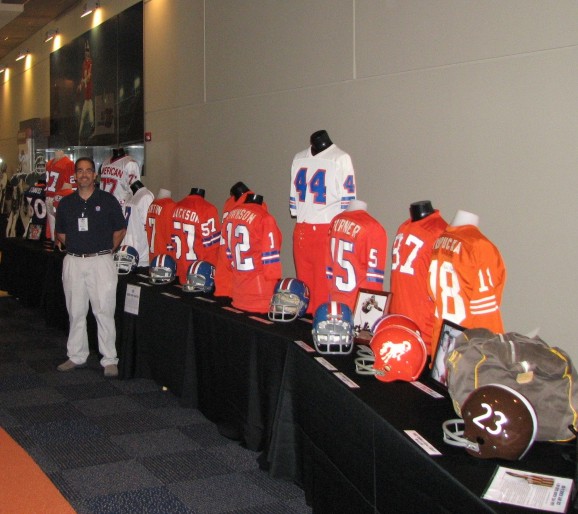
 HOF Receives Memorabilia from Zimmerman's Career (8/31/08) Pro Football Hall of Fame Class of 2008 Enshrinee Gary Zimmerman recently donated artifacts from his Hall of Fame career. The mementos include the helmet worn by Zimmerman during the 1994 NFL season, the jersey he wore during the 1996 Pro Bowl, as well as shoulder pads, shoes, and gloves.
HOF Receives Memorabilia from Zimmerman's Career (8/31/08) Pro Football Hall of Fame Class of 2008 Enshrinee Gary Zimmerman recently donated artifacts from his Hall of Fame career. The mementos include the helmet worn by Zimmerman during the 1994 NFL season, the jersey he wore during the 1996 Pro Bowl, as well as shoulder pads, shoes, and gloves.
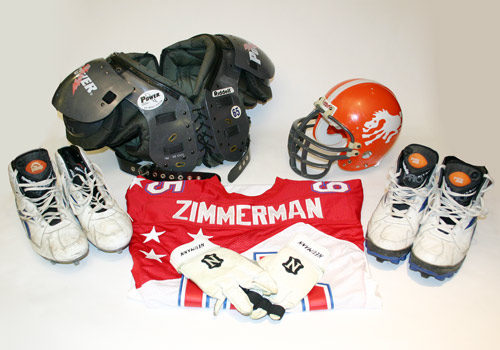
Zimmerman and the other members of the Class of 2008 - Fred Dean, Darrell Green, Art Monk, Emmitt Thomas, and Andre Tippett were formally inducted into the Pro Football Hall of Fame on Saturday Aug. 2.
Source: “Memorabilia from Gary Zimmerman's career” Pro Football Hall of Fame. 2008 (Jul 24). Online: http://www.profootballhof.com/hall/story.jsp?story_id=2772
 Predominantly Orange, For Real (8/31/08) An article published August 15 in the Denver Post indicated that the Broncos will be dusting off their alternative home jerseys for two games during the 2008 season with Broncos players wearing orange jerseys for home games Sept. 21 against New Orleans and Dec. 7 against Kansas City.
Predominantly Orange, For Real (8/31/08) An article published August 15 in the Denver Post indicated that the Broncos will be dusting off their alternative home jerseys for two games during the 2008 season with Broncos players wearing orange jerseys for home games Sept. 21 against New Orleans and Dec. 7 against Kansas City.
Having been four years since these last saw the field, the Broncos were last clad in the alternative home jerseys for a November 28, 2004 Sunday night game when they blew an 11-point, fourth-quarter lead in losing to Oakland, 25-24. According to the Post’s Mike Klis, “the all-orange look drew a scornful eye from Broncos coach Mike Shanahan. But as a compromise to a projected boost in merchandise sales, the Broncos are giving the orange jerseys another chance.”
 ESC To Appear at 2008 Fan Fair (5/2/08) Once again, Endzone Sports Charities will participate in the Denver Broncos’ Fan Fair event to be held at INVESCO Field on Saturday and Sunday, June 7-8. Appearing in the Broncos’ Museum, we will once again be displaying our Ring of Fame jersey collection, which includes examples of actual game jerseys representing the evolution of the team’s uniforms across five decades and worn by many of the team’s greatest players. Hours are 11AM to 5PM each day and we encourage local area fans to stop by and say hello if you are planning to attend. Additional information about the event can be found at the Denver Broncos’ website.
ESC To Appear at 2008 Fan Fair (5/2/08) Once again, Endzone Sports Charities will participate in the Denver Broncos’ Fan Fair event to be held at INVESCO Field on Saturday and Sunday, June 7-8. Appearing in the Broncos’ Museum, we will once again be displaying our Ring of Fame jersey collection, which includes examples of actual game jerseys representing the evolution of the team’s uniforms across five decades and worn by many of the team’s greatest players. Hours are 11AM to 5PM each day and we encourage local area fans to stop by and say hello if you are planning to attend. Additional information about the event can be found at the Denver Broncos’ website.
 New Info Re: Jersey ID (5/2/08) In the “it’s never too late to teach an ol’ dog new tricks” category, several recent examinations have shed new light on the categorization of Broncos jerseys from the 1978 through 1981 seasons as well as those from 1989-’90.
New Info Re: Jersey ID (5/2/08) In the “it’s never too late to teach an ol’ dog new tricks” category, several recent examinations have shed new light on the categorization of Broncos jerseys from the 1978 through 1981 seasons as well as those from 1989-’90.
For the years, 1978 and 1979 Wilson Sporting Goods was known to have provided the team’s uniforms after a several-years run of Russell Athletic having provided the team’s apparel. These Wilson jerseys could be easily identified by the distinguishing design characteristic of having the shoulder yoke and torso sections connected with a sharp diagonal seam, running from the mid-front sleeve up to the mid collar. Even with limited examinations, extensive photographic evidence supported that this style was only in use for two seasons before 1980 saw the return of the horizontal seam, characteristic of a Russell design.
In years past, the 1978-’79 jerseys were categorized collectively, as limited examinations failed to yield any significant differences in jerseys from these two years. More recent examinations, however, have identified a subtle difference in the manufacturer’s tagging which seems to differentiate the two years. From the period of about 1974 through 1977, the Wilson tagging, which is found sewn to the lower left tail, can be identified by the red scripted Wilson logo at the top of the tag, with care instructions below and sizing indicator to the right, with the registered trademark symbol (®) found at the upper right corner of the Wilson logo. Additionally, the “s” in the logo, does not quite come to a close at the bottom. Though the consensus of hobby experts seem to agree that this style of logo was last used about 1977, its use seems prominent on what we are now categorizing at 1978-period jerseys.
Conversely for 1979, while the design of the jersey remains nearly indistinguishable from their ’78 counterparts, a slight change in the tagging style differentiates the ’79 jerseys. While the main layout of the tagging remains the same, with the Wilson script logo above the washing instructions and to the right of the size identifier, the style typically associated with the 1978 to ’85 period features a trademark symbol that is relocated to the lower right corner of the logo and with a slight change to the scripted letting as well. Most notably is the “s”, which now comes to a complete close at the bottom. Samples of the 1978 and ’79 tagging are shown below.
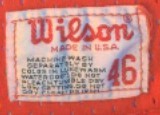
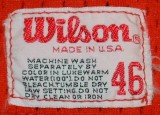
Limited in the past to only photographic study, available photos from this period seemed to lead us down an incorrect path. As a learning experience from this, one must consider that the typical lower-resolution photos of the period may not always provide indisputable evidence and thus caution must be taken to avoid “reading between the lines” of blurred pixels. And to think, people say that pictures don’t lie!
There are indeed other physical characteristics which distinguish the 1980-’81 Wilson jerseys from those of Russell Athletic, and these can be studied in detail in the respective “detail” sheets found on our Game Uniform Detail page, however, these minor details do not readily present themselves in most commonly available period photography of the day.
Similarly, the Wilson jerseys of the 1989 to 1990 period produced a comparable quandary. Nearly identical in physical characteristics, there is no significant variation between the jerseys from these two seasons that would allow the casual observer the ability to differentiate these. Recently, we have become aware that, again, a tagging style difference may separate the jerseys issued during these two seasons.
In the mid-1980s, while the Broncos were still donning Russell Athletic apparel, Wilson began utilizing a larger “Prestige” style manufacturer’s tag, which appeared to be fairly universal across their uniform product lines. Our initial awareness of the older-style tagging appearing on a few late-1980s to early ‘90s jerseys was thought to be somewhat of an anomaly. Recently, however, we were made aware of a jersey with this older (circa 1978-’85) style of tagging, bearing a manufacturing date code of “BU” (July 1989). Though this style of tagging would appear to remain uncommon for Wilson jerseys of the period, we have now examined a sufficient number of these to reinforce our belief that many, if not all Wilson-issued Broncos jerseys for the 1989 season would bare this style of tagging. We cannot, however, say with certainty, that some of the ’89 issues may have born the “Prestige” style of tagging as well. As originally theorized, we still believe that all of the 1990 issued jerseys all have the more recent “Prestige” style of tagging, as depicted below (at right)

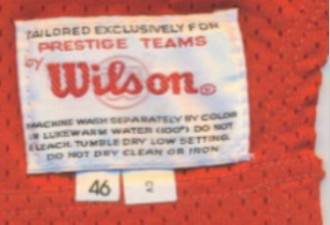
 ESCs Detail Specification Sheets Updated (5/2/08) In late 2007, ESC began the process of updating our yearly detail specification sheets to a new format. The original, having been created separately as information for a new jersey was added, often lacked continuity and consistency. The information contained therein, was also, for the most part limited to the team’s jerseys.
ESCs Detail Specification Sheets Updated (5/2/08) In late 2007, ESC began the process of updating our yearly detail specification sheets to a new format. The original, having been created separately as information for a new jersey was added, often lacked continuity and consistency. The information contained therein, was also, for the most part limited to the team’s jerseys.
The updated format now allows for specific information regarding the team’s helmets and pants for each year, though information for these is still sparse and in many cases estimated. As new information becomes available for these other uniform components, it can now be easily amended or added as needed, without disruption to the jersey information.
In going through each of these files to include the additional information, we also took the opportunity to edit previously available information to ensure more consistency. Having also recently added a significant number of new photographs to our photo reference library, we’ve taken the time to select new and improved game photos to be depicted as on-field representations of each year’s uniform.
Please take the opportunity to view these files, which are all viewable/downloadable in .pdf format at our Game Uniform Detail page. We would appreciate any feedback that you may have that will allow us to further improve this information at our next update.
 ESC To Offer Free Authentication (5/2/08) In order to expand our growing reference database, Endzone Sports Charities (ESC) will be offering free examination/authentication for select styles of Broncos jerseys so that exemplars from specific periods/years can be more thoroughly documented.
ESC To Offer Free Authentication (5/2/08) In order to expand our growing reference database, Endzone Sports Charities (ESC) will be offering free examination/authentication for select styles of Broncos jerseys so that exemplars from specific periods/years can be more thoroughly documented.
If you have one or more Broncos game jerseys from the list below, we would like to hear from you. In exchange for the opportunity to personally examine and document your jersey, ESC will provide:
Jerseys sought include the following: 1960-’61 home or road, 1962-’64 road, 1965-’66 home or road, 1967-’68 road, 1969-’71 home or road; 1972 road, 1973 home or road, 1975 road, 1976 home or road, 1977-’78 road, 1979 home, 1980-’83 home or road, 1984 home, 1985-’86 home or road, 1987 home, 1988 road, 1989-’91 home or road; 1993 road, 1994 “Throwback” home or road, 1995 road, 1997-’98 home or road, 1999 home, 2000 road, 2001 home “Throwback”, 2002 home, alternate or road, 2003 road, 2004 home, alternate or road, 2005 road, 2006-’07 home or road.
Please contact us via e-mail if you have items which you would consider submitting under this limited-time, promotional offer.
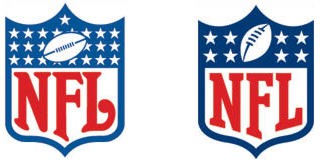
 New NFL Logo Unveiled For 2008 (5/2/08) Beginning with the 2008 National Football League draft, the league’s uniforms will be adorned with a new NFL logo. Nearly 30 years since the last change, the new design features a cleaner, more angular font, fewer stars—reduced from 25 to 8, one for each division—and a restyling of the football, which now appears similar to the one atop the Lombardi Trophy. Additionally, the colors used for the new logo are darker and the logo itself is taller and thinner.
New NFL Logo Unveiled For 2008 (5/2/08) Beginning with the 2008 National Football League draft, the league’s uniforms will be adorned with a new NFL logo. Nearly 30 years since the last change, the new design features a cleaner, more angular font, fewer stars—reduced from 25 to 8, one for each division—and a restyling of the football, which now appears similar to the one atop the Lombardi Trophy. Additionally, the colors used for the new logo are darker and the logo itself is taller and thinner.
 1960-’61 “Official” Colors IDd (5/3/08)
After fifteen years of research, ESC has finally uncovered the only known “official” reference to the Broncos team colors for the 1960 and ’61 seasons.
1960-’61 “Official” Colors IDd (5/3/08)
After fifteen years of research, ESC has finally uncovered the only known “official” reference to the Broncos team colors for the 1960 and ’61 seasons.
Having a near complete run of regular season programs from the inaugural season and a copy of the very rare 1960 Media Guide, not a single one of these publications made any reference to the teams’ colors. The teams’ uniforms, having been procured in used condition, were so inconsistent in color that it was impossible to derive a consensus from these either.
Generally yellow and brown in color, over the years we have seen the primary color being referred to as mustard, old gold, pale gold, etc., with the secondary color (brown) color being called by nearly as many monikers. It is well known that the brown pants varied wildly in hue, most likely coinciding with the extent of wear that each pair had seen prior to being inherited by the Broncos. Originally a dark brown color, some had faded to a nearly tan color by the end of the ’61 season. Even when “new” at the start of the 1960 season, some were know to have a satin sheen, while others were more drab or flat in this regard. There is no reason not to suspect that the gold home jerseys would not have exhibited similar color variations, also being hand-me-downs.
Recently ESC procured a copy of the program from the final 1960 exhibition season game, a Sep 2 contest against the Chargers in Los Angeles. The program included one-page team summaries for the Chargers and Broncos, as well as the Dallas Texans, who would be the Chargers; next opponent on opening day of the 1960 regular season. Each page included photos of several of each teams’ players along with brief personal stats and a team header which listed the name of each teams’ home stadium, its seating capacity, and the team’s colors. On page 23, highlighting the Broncos, the teams’ colors were listed as “Seal Brown and Light Gold”.
 Fan Fair Tales (9/1/07) On June 2nd and 3rd, Endzone Sports Charities (ESC) was honored to have been invited to display our Ring of Fame jersey collection as a part of the Denver Broncos 5th annual Fan Fair event, which was held at INVESCO Field at Mile High. Incorporated within the “Broncos Museum” display, our collection game-used jerseys were displayed along side the Broncos collection of memorabilia which included the two Vince Lombardi trophies awarded for Super Bowls XXXII and XXXIII as well as a half dozen Lamar Hunt trophies, representing AFC Championships victories following the 1977, 1986, 1987, 1989, 1997 and 1998 seasons.
Fan Fair Tales (9/1/07) On June 2nd and 3rd, Endzone Sports Charities (ESC) was honored to have been invited to display our Ring of Fame jersey collection as a part of the Denver Broncos 5th annual Fan Fair event, which was held at INVESCO Field at Mile High. Incorporated within the “Broncos Museum” display, our collection game-used jerseys were displayed along side the Broncos collection of memorabilia which included the two Vince Lombardi trophies awarded for Super Bowls XXXII and XXXIII as well as a half dozen Lamar Hunt trophies, representing AFC Championships victories following the 1977, 1986, 1987, 1989, 1997 and 1998 seasons.
ESC’s display consisted of jerseys worn by Ring of Fame inductees Craig Morton, Jim Turner, Tom Jackson, Louis Wright, Dennis Smith, Gary Zimmerman and Steve Atwater in addition to the three players whose uniform numbers have been retired—Frank Tripucka (#18), Floyd Little (44) and John Elway (#7). Also on display was our 1960-’61 game sock as well as other historically significant memorabilia. Game jerseys of Ring of Famers Charlie Johnson and Rich Jackson as well as a couple of AFL-era vintage helmets were displayed courtesy of Tom Jacobsen.
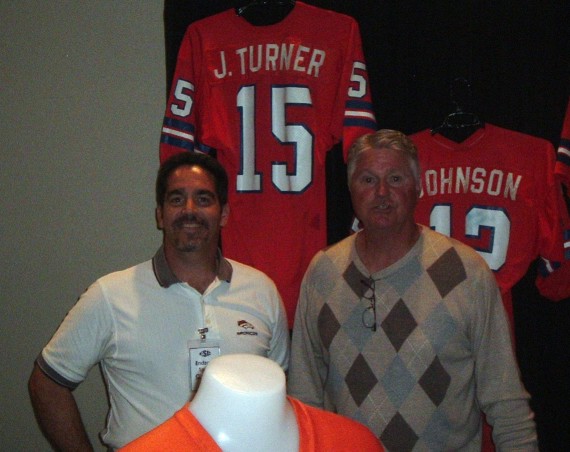
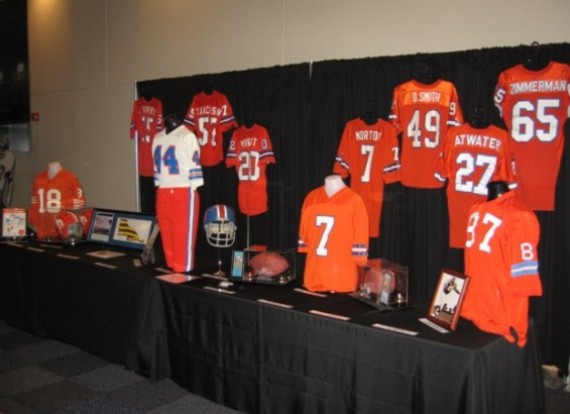
The event, which was attended by nearly 10,000 Broncos fans, featured autograph sessions from players, coaches and alumni, photo opportunities, contests, raffles, memorabilia booths, field activities and a viewing of the team’s 2006 highlight film.
ESC is already looking forward to bigger and better things for the 2008 event. With the induction of former Broncos running back Terrell Davis to the Ring of Fame (see article below), we will add our 2001 home game jersey to the display along with a collection of reproduction vintage-style helmets provided by Historic Helmets as well as other historically significant memorabilia.
 New Information Uncovered Regarding 1967-’68 Jerseys (9/1/07) AFL-era Denver Broncos jerseys remain elusive, with fewer than half a dozen having come to market publicly over the past decade or more. With their appearance being somewhat of a rare occurrence, opportunities to learn more about these early styles of jerseys are equally uncommon.
New Information Uncovered Regarding 1967-’68 Jerseys (9/1/07) AFL-era Denver Broncos jerseys remain elusive, with fewer than half a dozen having come to market publicly over the past decade or more. With their appearance being somewhat of a rare occurrence, opportunities to learn more about these early styles of jerseys are equally uncommon.
During the past two years, we have had the privilege of examining two different 1967-’68 vintage Broncos home jerseys. The first was that of Steve Tensi, a quarterback who played for the team from 1967 through 1970, which was acquired at auction by a local collector. The second, which was acquired by ESC, was that of Ring of Fame defensive end Rich “Tombstone” Jackson, whose tenure with the team spanned from 1967 through 1972. Obviously of similar manufacturer, these two shared identical design characteristics including Durene construction with 1/2-length sleeves, embedded knit sleeve striping, crew-neck rib-knit collar, and tackle-twill number identifiers. Two additional characteristics which these jerseys had in common were the elements that were missing. Both had their nameplates removed from the rear of the jerseys, as was commonplace for the period when the team often recycled game jersey for use in practice the following year(s). Secondly, due to extreme wear and subsequent laundering, the manufacturer’s tagging from both had long ago disappeared.
As such, the manufacturer of these jerseys was not readily identifiable. Based upon a composite of several pieces of information, a tentative identification of this unknown manufacturer was established. Examination of game photographs from this period established that the original manufacturer’s tag was affixed to the lower left tail of the jersey (see http://endzone.pscoggin.com/Graphics/reference/1968/1968_11_24_SmithP.htm ). Detailed examination of the Jackson jersey confirmed remnants of perimeter stitching in this area of the jersey measuring approximately 1 1/4" wide by 1” tall. This, along with comparison of other characteristics to known exemplars from the period has led to the tentative conclusion that theses jerseys were manufactured by Wilson Sporting Goods.
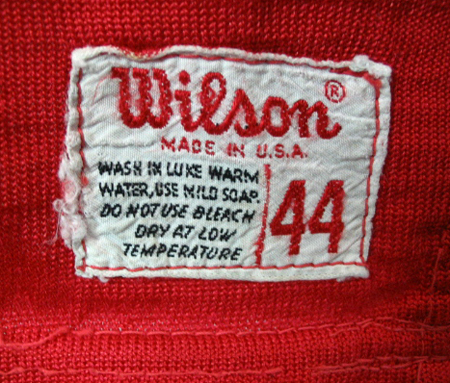
This conclusion was presumed to be the standard for all 1967-’68 era jerseys. Recently, however, ESC made contact with a collector in possession of a road jersey from this period worn by reserve tackle Tom Cichowski. With manufacture’s tagging in tact, the white road jersey displayed two-part manufacture’s and care tags showing Rawlings as the jersey’s supplier. Sharing many of the same characteristics as the two home jerseys, the Cichowski jersey such as Durene construction with 1/2-length sleeves, embedded knit sleeve striping, crew-neck rib-knit collar, and tackle-twill number identifiers.
Differences between the home and road jerseys are subtle and not easily discerned through photographic examination of game photos from the period. These differences become more readily noticeable when comparing the jerseys side-by-side. On the orange home jersey, the sleeve’s “TV” numbers are affixed lower on the sleeve relative to the sleeve’s embedded stripping, with only about 1/4" separating the bottom of the uniform number from the top edge of the striping. Also on the home jersey, the ribbed-knit sleeve cuffs measure approximately 1 1/4" in width. In contrast, the road-white Rawlings jersey displays more spacing between the sleeve’s uniform numbers and striping (approximately 1 1/4") and the ribbed-knit cuffs are slightly wider at approximately 1 1/2" in width. Also, the road-white jersey displays more width of underlying of the white material between the colored sleeve stripes, as opposed to the scant 1/8” of orange material separating the contrasting stripe on the home jersey.
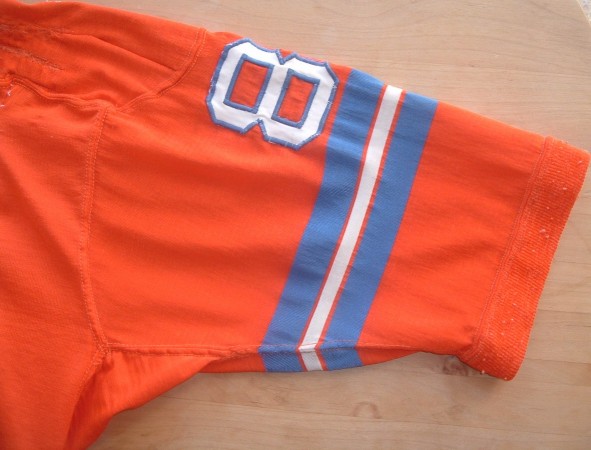
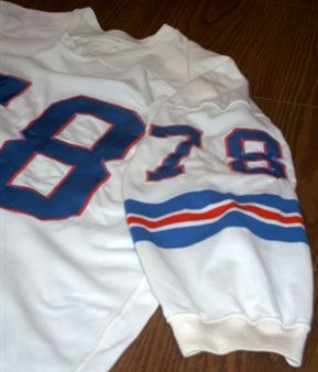
With a closer physical inspection of the Cichowski road jersey, it is likely that additional subtleties would also present themselves. As new information becomes available, it will be disseminated here as well.
 Broncos To Memorialize Fallen Teammates (9/1/07) For the 2007 season, members of the Denver Broncos will memorialize fallen teammates Darrent Williams (CB, 2005-2006) and Damien Nash (RB, 2006) who both passed unexpectedly this past off-season. The players will don a white circular sticker on the rear of their helmets with the imprinted numbers 27 and 29—representing Williams’ and Nash’s uniform numbers. The sticker will be placed on the left side of the helmets, immediately above each player’s own uniform number identifier.
Broncos To Memorialize Fallen Teammates (9/1/07) For the 2007 season, members of the Denver Broncos will memorialize fallen teammates Darrent Williams (CB, 2005-2006) and Damien Nash (RB, 2006) who both passed unexpectedly this past off-season. The players will don a white circular sticker on the rear of their helmets with the imprinted numbers 27 and 29—representing Williams’ and Nash’s uniform numbers. The sticker will be placed on the left side of the helmets, immediately above each player’s own uniform number identifier.
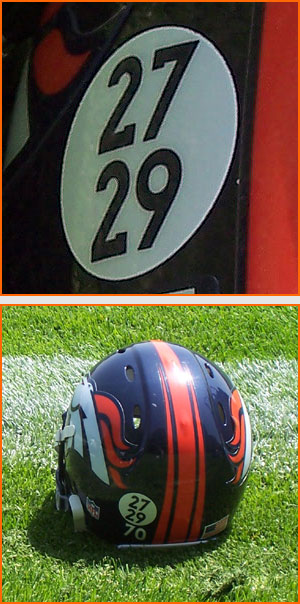
NFL teams are permitted to honor deceased players with decals affixed to their teams’ helmets throughout the season that follows a player’s death. During May’s quarterback camp, head coach Mike Shanahan said that the sticker is only the beginning of the Broncos’ plans to honor the players.
 Terrell Davis Named To Ring Of Fame (9/1/07) On Friday, July 28th, Denver Broncos President Pat Bowlen announced that Terrell Davis was voted into the team’s Ring of Fame. The selection was made by the Ring of Fame committee, which includes Bowlen, former General Manager John Beake, former team defensive coordinator Joe Collier, and former play-by-play voice Larry Zimmer of KOA radio.
Terrell Davis Named To Ring Of Fame (9/1/07) On Friday, July 28th, Denver Broncos President Pat Bowlen announced that Terrell Davis was voted into the team’s Ring of Fame. The selection was made by the Ring of Fame committee, which includes Bowlen, former General Manager John Beake, former team defensive coordinator Joe Collier, and former play-by-play voice Larry Zimmer of KOA radio.
Davis played for the Broncos from 1995-2001 and still holds 12 all-time Broncos records.
Among his honors and accomplishments, Davis:
Davis became a candidate for the Pro Football Hall of Fame in 2007 as well, and advanced to the final 25 in this past year’s voting.
He will be inducted into the Denver Broncos Ring of Fame on Sunday, Sept. 23 when the Broncos host the Jacksonville Jaguars, which has been designated as the team’s annual Alumni Reunion game.
 ESC’s “Endzone Report” To Receive Facelift (9/1/07) Periodically since 1996, ESC has published The Endzone Report, a newsletter focused on our organization’s educational/research activities and charitable projects. While distribution of the publication has varied over the years, the target audience was typically the Broncos’ alumni with whom we had directly worked in any number of our charitable endeavors. At last count this amounted to somewhat less than 100 former players.
ESC’s “Endzone Report” To Receive Facelift (9/1/07) Periodically since 1996, ESC has published The Endzone Report, a newsletter focused on our organization’s educational/research activities and charitable projects. While distribution of the publication has varied over the years, the target audience was typically the Broncos’ alumni with whom we had directly worked in any number of our charitable endeavors. At last count this amounted to somewhat less than 100 former players.
In recent years, as more Broncos’ alumni had become involved in our projects, much of the focus of the newsletter has migrated to covering their involvement in these projects. This past summer, ESC decided to refocus the format of this newsletter to more directly focus its content on the alumni’s activities. According to ESC director Patrick Scoggin, the newsletter will now be more of a networking medium, allowing former Broncos to connect to one another.
Commensurate with the format change, ESC plans to also expand the distribution of the publication to many more alumni than it has reached in the past. Whereas past distribution was limited to fewer than a hundred, we will now include these as well as all alumni living within the state of Colorado, as well as any outlying residents to whom we can deliver electronically.
 Fact and Fiction: Exceptions to the “Game-Used” Rules Abound (4/30/07) The old adage states that the only things that can be counted upon with any certainty is taxes and death. In the realm of collecting game-used jerseys, there seem to be no other certainties that can be added to this list. Despite years of historical research and documentation, we maintain the position that about the only thing that can be consistently counted upon as being absolute is that nothing is absolute.
Fact and Fiction: Exceptions to the “Game-Used” Rules Abound (4/30/07) The old adage states that the only things that can be counted upon with any certainty is taxes and death. In the realm of collecting game-used jerseys, there seem to be no other certainties that can be added to this list. Despite years of historical research and documentation, we maintain the position that about the only thing that can be consistently counted upon as being absolute is that nothing is absolute.
Variations in physical characteristics such as lettering/numerical fonts, materials, tagging, cuts and manufacturers all result in a plethora of deviations from the accepted “standard”. While important to have a comparative standard to which like items can be compared, collectors must recognize that the appearance of variations is to be expected in many cases. The authenticity of a given item in question needs to be assessed on the totality of information available and usually not based on a single disparity.
ESC’s site includes a collection of Broncos’ uniform detail pages which provide a basic framework for comparison. It is not our intent that these would be expected to be the final word in specifying the one and only standard for self-authentication. Rather, they provide information that has been gathered over time, sometimes from a single exemplar and at times through a process of amalgamation having inspecting multiple like items. As our research is an ongoing process, this data is continually updated as new information becomes available. Within our existing base of knowledge, known exceptions to standards exist and it is just as likely that many more undocumented exceptions are probable as well. Below we have identified some of the non-standard anomalies that we have encountered, all integrated within otherwise acceptable and legitimate, authentic jerseys:
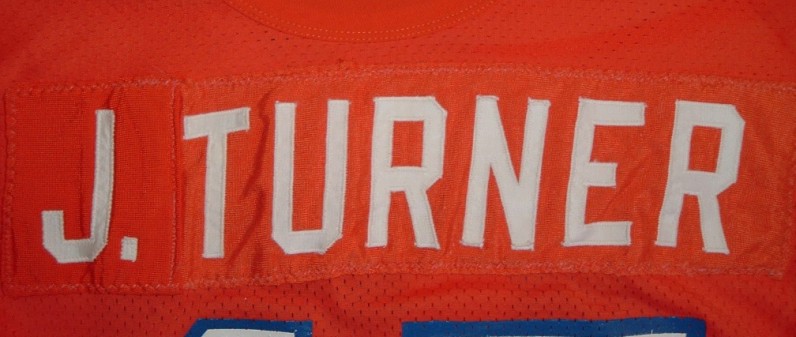
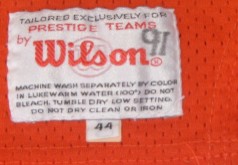
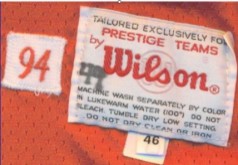
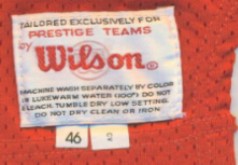
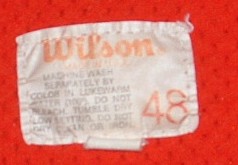
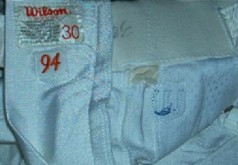
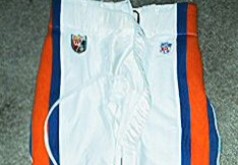
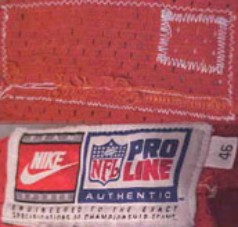
In addition to the designed variation inherent with the multitude of factory styles offered, many players are also prone to adding further custom tailoring to their jerseys. Shortening of body length and/or adding elastic to the jerseys tail, sleeve alterations, and body tapering are a few of the more common customizations.
As a result of both the number of styles offered, compounded by the customizations that often occur, establishing a “standard” regarding physical characteristics for any of these Reebok-era jerseys can be daunting.
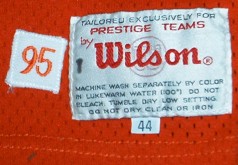
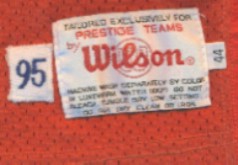
 2006 Uni Notes (4/30/07) Recapping the 2006 season, like the several which preceded it, there was little noticeable change in the Broncos 2006 Reebok uniforms. Only the year tagging serves to uniquely identify this past year’s crop of team apparel from the 2002-’05 editions.
2006 Uni Notes (4/30/07) Recapping the 2006 season, like the several which preceded it, there was little noticeable change in the Broncos 2006 Reebok uniforms. Only the year tagging serves to uniquely identify this past year’s crop of team apparel from the 2002-’05 editions.
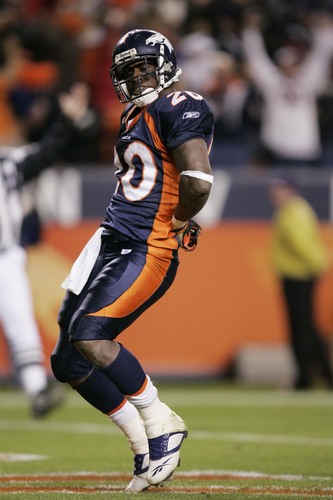
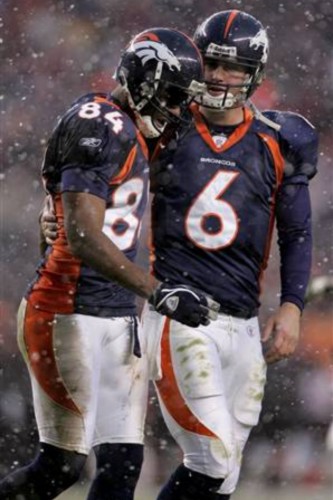
Here we will briefly review some of the players who made their Broncos debut during the 2006 season and note their observed uniform preferences:
 Three Broncos Semis For Hall of Fame (1/1/07) Former Denver Broncos running back Terrell Davis was one of three first-year eligible players to make the list of 25 semifinalists for the Pro Football Hall of Fame's Class of 2007 along with offensive lineman Bruce Matthews and guard Randall McDaniel.
Three Broncos Semis For Hall of Fame (1/1/07) Former Denver Broncos running back Terrell Davis was one of three first-year eligible players to make the list of 25 semifinalists for the Pro Football Hall of Fame's Class of 2007 along with offensive lineman Bruce Matthews and guard Randall McDaniel.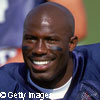
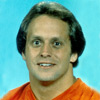

Joining the former league and Super Bowl MVP are linebacker Randy Gradishar and offensive tackle Gary Zimmerman. Gradishar was a finalist for the Hall of Fame in 2003 while Zimmerman has been a finalist in 2003, 2004 and 2006. On November 16th, the Hall of Fame's Board of Selectors chose the 25 semifinalists from the list of 111 preliminary nominees that was announced in late October. That list included four former Broncos who did not make the semifinalist cut: safety Steve Atwater, linebacker Karl Mecklenburg, former head coach Dan Reeves and cornerback Louis Wright.
To be considered for election to the Pro Football Hall of Fame, a nominated player must have been retired at least five years. For a non-player, there is not a mandatory retirement period, but a coach must be retired before he may be considered. A contributor, who is a nominee who has made outstanding contributions to pro football in capacities other than playing and coaching, may still be active in his pro football career.
The Class of 2007 will be determined at the Selection Committee's annual meeting on Saturday, February 3, 2007, in Miami, Florida, the day before Super Bowl XLI. The election results are announced immediately following the meeting at a press conference at the media headquarters. Hall of Fame bylaws stipulate that between three and six new members will be selected each year.
Davis, in his first year of eligibility for the Hall of Fame, amassed 7,607 rushing yards over his seven-year career and holds almost every Broncos rushing record. He also won three league rushing titles and was the league's Most Valuable Player in 1998, as well as the MVP of Super Bowl XXXII.
Gradishar spent 10 years at linebacker for the orange and blue, never missing a game. He was a seven-time Pro Bowler and is also the all-time leader in tackles for the Broncos, finishing with 2,049.
Zimmerman came to the Broncos in 1993 via a trade from the Minnesota Vikings. He was named All-NFL four times (1986-88, 1996), NFL Lineman of the Year in 1987, and second-team All-NFL of the 1980s. He helped lead an offensive line that was integral in helping Denver win its first Super Bowl in 1997.
Also among the 25 semifinalists was wide receiver Andre Reed, who spent training camp in 2000 with the Broncos.
 Williams Dies at 24 (1/2/07)Tragedy struck the Broncos and the National Football League on Monday morning when cornerback Darrent Williams was shot and killed in the overnight hours of New Year's morning.
Williams Dies at 24 (1/2/07)Tragedy struck the Broncos and the National Football League on Monday morning when cornerback Darrent Williams was shot and killed in the overnight hours of New Year's morning.
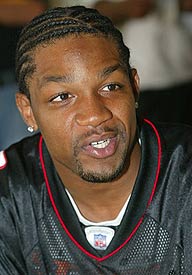
He was 24 years old.
Williams was just hours removed from playing extensively during the Broncos' season-ending 26-23 overtime loss to the San Francisco 49ers, a game in which he logged three tackles and returned a pair of punts for 50 yards, including a 34-yarder that was his longest of the season.
The Oklahoma State product joined the Broncos as a second-round draft pick in 2005 and immediately made an impact upon the team, rising to the first team before the campaign was halfway complete. He finished his first year as a first-team All-Rookie selection by Pro Football Weekly and the Pro Football Writers Association, logging 58 total tackles, intercepting two passes -- one of which he returned for a touchdown at Oakland -- and adding a sack.
"(Darrent) lived his life to the fullest," his mother, Rosalind Williams, told the Fort Worth Star-Telegram. He had a big heart and helped many people," Rosalind Williams said. "He's going to be sorely missed by his family and friends and he has a big family. I don't mean just blood relatives. It is such an extended family because there's so many people that loved him."
Many of them were in the Broncos' locker room.
(Source: DenverBroncos.com)
 ESC Interviews 1960 Broncos Alum Frank Bernardi (9/5/06) In August-September 2006, Patrick Scoggin of Endzone Sports Charities had the opportunity to pose questions to former Denver Bronco Frank Bernardi. An alumni of the University of Colorado, Mr. Bernardi was a defensive back, playing six games with the team during its’ inaugural 1960 season.
ESC Interviews 1960 Broncos Alum Frank Bernardi (9/5/06) In August-September 2006, Patrick Scoggin of Endzone Sports Charities had the opportunity to pose questions to former Denver Bronco Frank Bernardi. An alumni of the University of Colorado, Mr. Bernardi was a defensive back, playing six games with the team during its’ inaugural 1960 season.
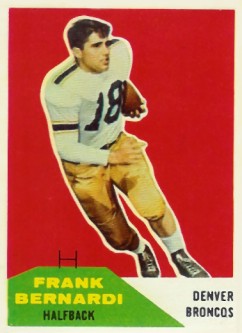 ESC: How did you come about joining up with the fledgling American Football League (AFL)’s 1960 Broncos?
ESC: How did you come about joining up with the fledgling American Football League (AFL)’s 1960 Broncos? ESC Offering Jersey Authentication Service (4/30/06) Effective May 1st 2006, Endzone Sports Charities (ESC) is pleased to announce broader availability of its’ jersey authentication services. Previously available only on a limited basis, this service—limited exclusively to Denver Broncos jerseys—will now be made available to the general public. By limiting items that we will accept for examination to only those items which fall within our area of expertise, we can offer our clients unparalleled service with a unique fee structure that is both competitively priced for our commercial clients as well as being tax-advantaged for individuals as well.
ESC Offering Jersey Authentication Service (4/30/06) Effective May 1st 2006, Endzone Sports Charities (ESC) is pleased to announce broader availability of its’ jersey authentication services. Previously available only on a limited basis, this service—limited exclusively to Denver Broncos jerseys—will now be made available to the general public. By limiting items that we will accept for examination to only those items which fall within our area of expertise, we can offer our clients unparalleled service with a unique fee structure that is both competitively priced for our commercial clients as well as being tax-advantaged for individuals as well.
ESC will provide authentication services by one of the hobby’s most respected collectors and researchers, Patrick Scoggin. Patrick is considered by collectors and dealers alike throughout the hobby as the foremost expert regarding Denver Broncos uniforms. With over 15 years experience collecting and authenticating Denver Broncos game-used apparel and memorabilia, Scoggin owns a historically significant collection of Denver Broncos game-used memorabilia covering the teams’ four-decade history, including many unique one-of-a-kind items and he maintains an extensive team-related uniform reference library consisting of various media including photographs, literature and video.
Unique to ESC will be its’ fee structure. ESC will charge an industry-low non-tiered single base fee for any jersey that we examine. It will be our policy to do so since we will spend practically the same amount of time with the $150 common player’s jersey as we will with the $2,000 star or vintage jersey. Likewise, just as we will spend the time to document why, in our opinion, your jersey may be correct, if it is not, we will take the time to document the reason(s) for this as well. Also, as the secondary mission of ESC is to provide financial support to positively impact the lives of others, 100% of the fees collected from our authentication services are to be forwarded as a fully tax-deductible donation to the NFL Alumni in support of its “Caring for Kids” charitable efforts throughout the Rocky Mountain region.
For more detailed information on our jersey examination services or to submit an item for authentication, visit our Authentication Page.
 Former Broncos DT Lewis P. “Bud” McFadin Passes Aaway (1/15/06)
Former Broncos DT Lewis P. “Bud” McFadin Passes Aaway (1/15/06)ENGLEWOOD, Colo. — Former Denver Broncos defensive tackle Lewis P. “Bud” McFadin, a five-time NFL/AFL All-Star who was a member of the inaugural 1960 Broncos team, passed away Monday at the age of 77.
McFadin played for the Broncos from 1960-63 and appeared in all 56 games for the club during that period. He was tabbed an Associated Press All-Pro in each of his four seasons in Denver and participated in the AFL All-Star Game from 1961-63.
McFadin joined the Broncos after playing his first five professional seasons (1952-56) with the Los Angeles Rams, who selected the University of Texas All-American guard in the first round of the 1951 NFL Draft. He was voted to the NFL Pro Bowl in each of his final two seasons with the Rams, including the 1955 campaign when he also received Associated Press All-Pro recognition.
A native of Iraan, Texas, McFadin played his final two seasons with the AFL’s Houston Oilers from 1964-65.
In 11 professional seasons, McFadin appeared in 125 career regular-season games and scored 24 points (3 fumble recoveries, 2 field goals). He also recorded one interception.
The funeral service for McFadin will be held Thursday at 4 p.m. at Rocky Creek Baptist Church in Victoria, Texas (1147 Reinecke Road).
Source: DenverBroncos.com - http://www.denverbroncos.com/page.php?id=338&storyID=5329 ESC Interviews Former Broncos Equipment Guru Larry Elliott (1/1/06)
ESC Interviews Former Broncos Equipment Guru Larry Elliott (1/1/06) In December 2005, Patrick Scoggin of Endzone Sports Charities had the rare privilege of posing questions to former Denver Broncos’ equipment manager Larry Elliott. Responsible for handling the large amounts of equipment needed to outfit and supply a professional football team, Mr. Elliott, served in the capacity as the Broncos’ equipment manager’s from 1965 through 1982. In addition to his primary duty, Mr. Elliot was also responsible for pre-season training camp arrangements and road game lodging.
In December 2005, Patrick Scoggin of Endzone Sports Charities had the rare privilege of posing questions to former Denver Broncos’ equipment manager Larry Elliott. Responsible for handling the large amounts of equipment needed to outfit and supply a professional football team, Mr. Elliott, served in the capacity as the Broncos’ equipment manager’s from 1965 through 1982. In addition to his primary duty, Mr. Elliot was also responsible for pre-season training camp arrangements and road game lodging.
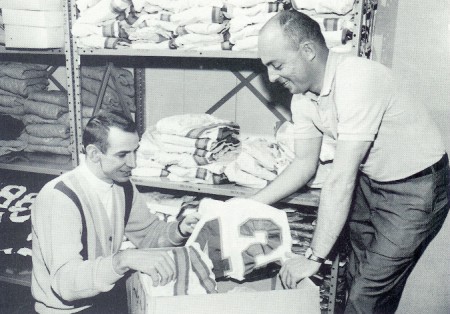 (Equipment manager Larry Elliot, standing at right, is assisted by trainer Allen Hurst in loading spare Broncos uniforms for shipment to Vietnam, circa 1970)
(Equipment manager Larry Elliot, standing at right, is assisted by trainer Allen Hurst in loading spare Broncos uniforms for shipment to Vietnam, circa 1970)
 Broncos Endzone to Expand & Receive Facelift (1/1/06) Beginning with changes in this month’s update, a gradual revision and expansion of the Broncos Endzone web site is now underway. Having recently expanded our hosting capacity, over time we are looking forward to adding additional uniform research resources.
Beginning this month, regular readers will notice more subtle changes… In November and December of 2005, all of the annual detail pages were reformatted and many were revised, incorporating new and additional information and/or graphics. Having recently adopted a new e-mail address, we have also eliminated our e-mail link on most pages, opting instead for a separate page providing a form which will allow for direct submissions of messages to us. For those with a need to e-mail us from outside our site, our new e-mail address, is endzonesports @ msn.com. Also apparent will be the streamlining of the site as information from several former pages is consolidated into a more easily navigated site.
In the coming months, it is our hope that the site will take on a more dramatic new look as we begin our search for assistance in the areas of both graphic and web design. While we have the conceptual design in place, converting the image to reality may take awhile considering that we are committed to remaining a privately funded, non-commercial site. Though the cosmetic changes may not progress as quickly as we’d like, we’ll do our best to ensure that we continue to provide top-quality content as we always have. Stay tuned...
Broncos Endzone to Expand & Receive Facelift (1/1/06) Beginning with changes in this month’s update, a gradual revision and expansion of the Broncos Endzone web site is now underway. Having recently expanded our hosting capacity, over time we are looking forward to adding additional uniform research resources.
Beginning this month, regular readers will notice more subtle changes… In November and December of 2005, all of the annual detail pages were reformatted and many were revised, incorporating new and additional information and/or graphics. Having recently adopted a new e-mail address, we have also eliminated our e-mail link on most pages, opting instead for a separate page providing a form which will allow for direct submissions of messages to us. For those with a need to e-mail us from outside our site, our new e-mail address, is endzonesports @ msn.com. Also apparent will be the streamlining of the site as information from several former pages is consolidated into a more easily navigated site.
In the coming months, it is our hope that the site will take on a more dramatic new look as we begin our search for assistance in the areas of both graphic and web design. While we have the conceptual design in place, converting the image to reality may take awhile considering that we are committed to remaining a privately funded, non-commercial site. Though the cosmetic changes may not progress as quickly as we’d like, we’ll do our best to ensure that we continue to provide top-quality content as we always have. Stay tuned...
 ESC’s Scoggin to Write Guest “Musings” Column at www.JimYackel.com (1/1/06) Humbled and honored, Endzone Sports’ Patrick Scoggin has been asked to contribute a guest column to Jim Yackel’s Weekly Editorial Musings column at www.jimyackel.com. With a little over a month to sharpen pencil and wit, the musings column is tentatively set to post on February 12th.
ESC’s Scoggin to Write Guest “Musings” Column at www.JimYackel.com (1/1/06) Humbled and honored, Endzone Sports’ Patrick Scoggin has been asked to contribute a guest column to Jim Yackel’s Weekly Editorial Musings column at www.jimyackel.com. With a little over a month to sharpen pencil and wit, the musings column is tentatively set to post on February 12th.
 NFL Goes International (1/1/06) To commemorate the NFL's first regular- season game outside the United States--the Arizona Cardinals faced the San Francisco 49ers on Sunday, October 2nd in Mexico City--all of the league's players (with the apparent exception of Broncos quarterback Jake Plummer) wore a green Futbol Americano sticker on their helmets for the day’s games.
NFL Goes International (1/1/06) To commemorate the NFL's first regular- season game outside the United States--the Arizona Cardinals faced the San Francisco 49ers on Sunday, October 2nd in Mexico City--all of the league's players (with the apparent exception of Broncos quarterback Jake Plummer) wore a green Futbol Americano sticker on their helmets for the day’s games.
 Broncos.com Interview Valenti
(9/7/05). As a collector of game-used jerseys, one’s best friend could easily be the team’s equipment manager. Not necessarily as a source of items for the collection, but at the very least as a source of information about the items that are being collected.
Broncos.com Interview Valenti
(9/7/05). As a collector of game-used jerseys, one’s best friend could easily be the team’s equipment manager. Not necessarily as a source of items for the collection, but at the very least as a source of information about the items that are being collected.
Earlier this summer denverbroncos.com interviewed Broncos’ current equipment manager Chris Valenti and queried him on several aspects of his job. Several of his responses to questions posed provided information of particular interest to Broncos’ uniform/jersey collectors.
From this interview it can be determined that the current practice is that each player is issued one (each home and road) jersey for the entire season. Each player also has a back up jersey prepared in case the primary one becomes unusable for some reason. The uniforms are hand scrubbed, laundered and repaired each week with the goal of making everything look new. Like the jerseys and pants, helmets receive touch-up paint and are re-decaled on a weekly basis in order to maintain a polished appearance. Players will generally use the same helmet for the entire year and are given the helmet at years’ end. Regarding purported game-worn helmets being offered on eBay, Valenti states that since “the helmets are actually given to each of the players at the end of every season so if it is being sold, it would have been obtained from the player himself.”
As to cleats, players are allowed to wear any type of cleat that they would like to. However, only two brands are allowed to show their logos on the field, those being Nike and Reebok. A player may choose to wear another brand, however, if he does so, all logos must be covered. If a player is lucky enough to get a shoe contract from one of the two mentioned brands, then their shoes are provided for them as part of the contract. For those players without contracts, the team provides them with the shoes they need to perform.
 "Unique" Elway Jerseys Abound
(5/8/05). In 1994, the National Football League, in recognition of its' 75th anniversary, celebrated in part, by asking its' member teams to don uniforms paying homage to teams of the past. For a home game in Denver versus the Raiders on September 18th and a road game in Buffalo on September 26th against the Bills, the Broncos wore "throwback" uniforms patterned after the style worn by the 1966 AFL-era team.
"Unique" Elway Jerseys Abound
(5/8/05). In 1994, the National Football League, in recognition of its' 75th anniversary, celebrated in part, by asking its' member teams to don uniforms paying homage to teams of the past. For a home game in Denver versus the Raiders on September 18th and a road game in Buffalo on September 26th against the Bills, the Broncos wore "throwback" uniforms patterned after the style worn by the 1966 AFL-era team.
As these two distinct modern jerseys—one orange home and one white road—were each used for only one game each, it is fair to say that they constitute the rarest of any post-merger-era Broncos jersey style. As was the common practice during the mid-90s, the team equipment staff would likely have prepared two of each jersey for each player on the team's roster at the time —one prepared for game use and one made "game ready" and held in reserve in case the actual game jersey should be damaged beyond repair during play. In theory, for each player who took the field for each of the two games, during the '94 season, there should be a single game-worn/used jersey as well as possibly a single "team-issued" (though not worn/used) jersey. Though possible that exceptions may exist, it would be expected that this would be the standard.
With that said, one would have to question the abundance of these Throwback jerseys that have appeared on the market and auction circuit in recent years. In its' recent "Opening Day" auction, which ended April 7, 2005, American Memorabilia of Las Vegas, NV offering what appeared to be its third, apparently different road throwback jersey of Hall of Fame quarterback John Elway. Lot #20, which closed at $2,221 (including 15% buyer's premium) was described as a "scarce 1994 Denver Broncos road throwback gamer with an absolutely perfect silver signature" displaying "solid game use". In their October 2004 auction, lot 48 was cataloged with "Awesome quarterback wear" and "signed in perfect black Sharpie on back" and sold for $6,335 (including buyer's premium) while in September of 2002, Lot #115 (which brought $4,637, including premium) was unautographed with only "light QB wear". All three of these jerseys were sized 48 and authenticated for American Memorabilia by Lou Lampson. When contacted by ESC, a representative of American Memorabilia stated that, “we have to go by our authenticator’s opinion”, despite that fact that the authenticator will apparently churn out a letter for a newly submitted piece every couple of years, which flies in the face of common sense.

Our research has uncovered that, in addition to the previously mentioned trio from American Memorabilia, at least three others have passed through the doors of Grey Flannel over the years. One was offered as lot #1130 in their May 2001 "Spring Training" auction and sold for $9,300. We were also aware of two other road "throwbacks" with Grey Flannel letters of authenticity (M.N. 949B, dated 7/10/95 and R.V. 342E, dated 2/9/98). Of note is that all three of these were of different sizes (44, 46, and 48 respectively).
Further muddling matters, an October 2000 article in the Denver Rocky Mountain News highlighted several pieces of Broncos' memorabilia that were part of the Pro Football Hall of Fame's collection. One of the items mentioned was "John Elway's complete Throwback uniform from the 1994 season." Contacting Jason Aikens of the Hall of Fame, we made an inquiry as to whether the hall possessed Elway's orange home jersey or his road white and also inquired as to the jersey's size. Mr. Aikens responded stating, "Our Elway throwbacks jersey is white and size 44."
Though unconfirmed, it is suspected that at least some of these jerseys may have originated from a lot that was created though a business partnership. In 1995 a Denver-area memorabilia dealer was contacted about purchasing the remaining stock of unused Wilson Throwback jersey blanks. The dealer acquired these jersey blanks—the same exact blanks as those provided to the team—and had the entire lot made up as Elway jerseys with appropriate numbers and nameplates. The dealer entered into an agreement with John Elway whereas, in exchange for his autograph on a number of the jerseys, which the dealer would retain for sale, John would be given a quantity in payment for his services, to do with as he wished. It is suspected that these likely were given away as gifts, donated for charitable functions and the like, with no way of telling exactly how many of these may now be circulating accompanied by "game worn" credentials.
Though not neatly as prominent, the orange home jerseys are apparently not without multiples either. The first that we are aware of was sold at auction by Grey Flannel in November of 2000 (a size 46 which brought $8,349 including 15% premium) and a second which recently closed at Vintage Authentic's March 31st, 2005 auction (lot #16, a size 48 selling for $3,680 including buyers premium with a "9/18/94 vs LA" notation on the Wilson tail tag written in black Sharpie).
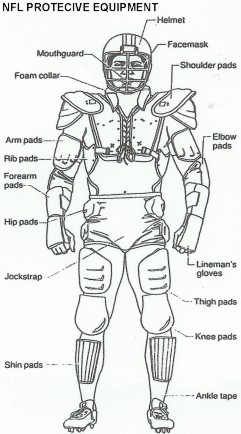
 Flashback 1989: Outfitting The NFL (5/8/05). Equipping an NFL team can be a challenging, not to mention expensive, task.
Flashback 1989: Outfitting The NFL (5/8/05). Equipping an NFL team can be a challenging, not to mention expensive, task.
The most visible portion of a player's "equipment" is his uniform. Uniforms help give a team its personality. They also bond the players on a team in a special fraternity that ties the wearers to a past tradition.
For the most part, NFL teams are free to choose their own uniform colors and designs. There are certain uniform standards established by the league, however, and compliance is moni-tored by NFL observers at every game.
All NFL teams are required to have one set of colored jerseys and one set of white jerseys. At one time the league rule stated that the home team would wear colored jerseys and the visit-ing team would wear white. Now the rule is that the home team has first choice.
Some superstitions have inevitably developed regarding the success a team has in either its col-ored or its white jerseys. As a result, some interesting psychological dramas have been played out over the choice of uniform colors.
Some NFL coaches always prefer to have their teams play in the all white uniforms because of a longstanding belief that players appear larger in white.
There is sometimes even a strategy behind the size of a uniform jersey. Offensive linemen often will wear jerseys that are actually too small for them so that the fit is skin tight. The reason? Defensive linemen won't have anything to grab onto. And now that pass blockers are allowed to use their hands more while protecting the quarterback, defensive linemen have become more conscious of wearing tight-fitting uniform jerseys as well.
The design of a team's helmet also has been used to gain an edge. In 1978, the New York Jets changed uniforms and went from white to green helmets, so that they would be the only team in the AFC Eastern Division that didn't wear white. They thought the green helmets would prove advantageous to a quarterback trying to pick out receivers.
Footwear has changed right along with hel-mets and jerseys. The advent of artificial play-ing surfaces has resulted in new types of footwear for NFL players. There is a different kind of shoe for every surface, and every NFL player is equipped with a variety of shoe surface options.
Gloves also are a part of some players' equip-ment. Offensive linemen wear thick, heavy gloves to protect their fingers from the rigors of line play. Wide receivers and tight ends some-times wear thin gloves on cold days to keep their hands warm.
Underneath the colorful uniform jerseys and pants there is another uniform: a layer of pro-tective equipment that has been designed and upgraded through the years to help prevent injury. The NFL also has standards that require all players to wear the same basic padding.
Shoulder pads, elbow pads, hip pads, thigh pads, and knee pads are all part of an NFL player's armor, in addition to his jockstrap, mouthpiece, and helmet.
A player's most important piece of equipment is his helmet. Football helmets have undergone dramatic evolution, from the flimsy leather headgear worn in pro football's early days to the energy absorbing, plastic helmets of the space age that contain air cells or liquid to lessen the effects of shock. New helmet designs constantly are being tested for improved safety measures to reduce the risk of head injury.
Actually, there have been a number of novel inventions during the past decade that have revolutionized some elements and theories sur-rounding football equipment.
A player with severely bruised, or even cracked ribs may still be able to play football, thanks to the flak jacket, which features a net-work of shock absorbing, air-filled tubes encased by a lightweight, plastic shell. And experiments, looking well into the future, have been done with spring-operated pads that will prevent rota-tion of the knee and disperse any severe shock on the knee joint upward to the leg and upper thigh (which can absorb the impact more eas-ily). Work also has been done on a pulley--operated pad system that works like an automo-bile seat belt in holding the neck steady during a heavy blow.
Presently it can cost a team as much as $100,000 or more to equip its players for an entire season. Even a simple item such as adhe-sive tape can entail a considerable expense. Every player has his ankles taped before practice or a game (by league rule), and many players also have other areas taped as well. One NFL trainer estimates that he will use more than 300 miles of tape during the course of a 20-game season, at a cost of nearly $30,000.
Source: Broncos GameDay, October 1, 1989 (Courtesy of The Illustrated NFL Playbook)
 State of the Hobby Roundtable (9/3/04). What is the current state of the game-worn hobby? Is the future bright or dismal? These are the questions on many collectors’ minds. We thought what better way to find out than to pose these questions to a panel of some of the hobby’s best known and most trusted experts. What follows are the responses from our esteemed panel, which consisted of:
State of the Hobby Roundtable (9/3/04). What is the current state of the game-worn hobby? Is the future bright or dismal? These are the questions on many collectors’ minds. We thought what better way to find out than to pose these questions to a panel of some of the hobby’s best known and most trusted experts. What follows are the responses from our esteemed panel, which consisted of:  Broncos to Don Orange Jerseys for ‘03 (9/3/04). This past summer, the Denver Broncos announced that they would don their orange third jerseys for the team's Sunday night home game against the Oakland Raiders on November 28. This game will mark the first appearance of the alternate uniforms since November 22, 2002, when the team donned them for another Sunday night game, against the Indianapolis Colts (see Broncos Re-Equip For '02 at News Archives Page).
Brandishing the orange togs for one game a season comes with a stamp of approval from team owner Pat Bowlen who had indicated in March of this year that the team would wear the alternate jerseys again, if given the opportunity.
Broncos to Don Orange Jerseys for ‘03 (9/3/04). This past summer, the Denver Broncos announced that they would don their orange third jerseys for the team's Sunday night home game against the Oakland Raiders on November 28. This game will mark the first appearance of the alternate uniforms since November 22, 2002, when the team donned them for another Sunday night game, against the Indianapolis Colts (see Broncos Re-Equip For '02 at News Archives Page).
Brandishing the orange togs for one game a season comes with a stamp of approval from team owner Pat Bowlen who had indicated in March of this year that the team would wear the alternate jerseys again, if given the opportunity.
 Broncos Memories Stored in Canton (9/3/04). After over four decades, Denver has finally seen its first career Broncos' player enshrined in the Pro Football Hall of Fame. In addition to John Elway's bronze bust, the team has been represented in Canton, Ohio, in other ways as well. Uniform items that are a part of the Hall's collection include:
Broncos Memories Stored in Canton (9/3/04). After over four decades, Denver has finally seen its first career Broncos' player enshrined in the Pro Football Hall of Fame. In addition to John Elway's bronze bust, the team has been represented in Canton, Ohio, in other ways as well. Uniform items that are a part of the Hall's collection include:
 New Info Leads To Re-Dating of Turner Jersey
(3/26/04). The more experience one has in dealing with game-worn jerseys, the more likely one is to realize the (lack of) depth of ones' knowledge. Such was the case recently as we were in the process of digitizing our archive of video tapes. While reviewing the 1972 Broncos team highlight film, "The Season of ’72", we spotted what appeared to be a familiar looking jersey… An orange, home jersey worn by Ring of Famer Jim Turner, distinguished by the rather unique nameplate markings of "J. TURNER".
Much like the Turner jersey in ESCs collection, I wondered how many could have had the first initial added to the nameplate during his nine year Bronco career. I surmised that it had to have occurred at least twice… Once in 1972 as evidenced by the recently viewed video and at least a second time in January of '78 since ours was known to have been a '77 vintage that was worn during Super Bowl XII. How did we know this? Not from any irrefutable provenance, in-depth research or other evidence. Nope. We just took the word of the guy from which we'd obtained it, based on the fact that he had no motivation to misrepresent it. Pretty naïve huh? Well, that's pretty much the way things were back in the day.
Today, forensic research is much more apt to point us towards the truth. As such, we started by asking what we knew about this so-called "1977" Jim Tuner jersey. In addition to the first initial addition to the nameplate, our jersey also had an additional unique feature to aid in its dating. Although the jersey was a nylon-mesh, typical of Russell jerseys of the 1970s, the nameplate material was a nylon-cotton blend durene fabric.
As to the first name initial, these are generally used only when more that one player of the same last name is on a teams' roster in a given year. In 1971 and 1972 there were two Turners on the Broncos' rosters, Jim, the Ring of Fame placekicker and Clem, a running back, thereby necessitating the use of first initials for both players during these two years. As no other player named Turner played for the team during Jim's career, these would have been the only two years that his jersey would have likely have had the first-name initial.
In previous examination of photographic evidence, 1972 is regarded as the first year in which nylon-mesh jerseys were worn by the Broncos making 1971 the final year of widespread wear of the durene jerseys. The Turner jersey in question displays a durene nameplate with tackle-twill lettering, sewn onto the back of a nylon-mesh jersey. While unconfirmed, it is suspected that the nameplate was likely removed from Turner's 1971 durene jersey and recycled for use onto the back of the '72-era nylon-mesh jersey.
In addition to the direct evidence, there is also some additional comparative evidence which comes into play. When comparing the Turner jersey to the white Floyd Little jersey from our collection, which was estimated to be from the 1972 to '74 period, the similarities are numerous. Design and fabrication details are nearly identical aside from some minor dimensional differences due to sizing (the Little jersey is a 44 and the Turner jersey, while not tagged, appears to be a 42). At the same time, such reclassification negates the inconsistencies between the subject Turner jersey and a Bobby Maples home jersey that was also presented as an exemplar of a 1977 vintage jersey (hemmed vs. banded sleeves and tackle-twill vs. heat set lettering). Based upon this new evidence, the Turner jersey that was previously classified as a 1977 jersey is being reclassified as a 1972-era jersey.
And who says you can’t teach an old dog new tricks?
New Info Leads To Re-Dating of Turner Jersey
(3/26/04). The more experience one has in dealing with game-worn jerseys, the more likely one is to realize the (lack of) depth of ones' knowledge. Such was the case recently as we were in the process of digitizing our archive of video tapes. While reviewing the 1972 Broncos team highlight film, "The Season of ’72", we spotted what appeared to be a familiar looking jersey… An orange, home jersey worn by Ring of Famer Jim Turner, distinguished by the rather unique nameplate markings of "J. TURNER".
Much like the Turner jersey in ESCs collection, I wondered how many could have had the first initial added to the nameplate during his nine year Bronco career. I surmised that it had to have occurred at least twice… Once in 1972 as evidenced by the recently viewed video and at least a second time in January of '78 since ours was known to have been a '77 vintage that was worn during Super Bowl XII. How did we know this? Not from any irrefutable provenance, in-depth research or other evidence. Nope. We just took the word of the guy from which we'd obtained it, based on the fact that he had no motivation to misrepresent it. Pretty naïve huh? Well, that's pretty much the way things were back in the day.
Today, forensic research is much more apt to point us towards the truth. As such, we started by asking what we knew about this so-called "1977" Jim Tuner jersey. In addition to the first initial addition to the nameplate, our jersey also had an additional unique feature to aid in its dating. Although the jersey was a nylon-mesh, typical of Russell jerseys of the 1970s, the nameplate material was a nylon-cotton blend durene fabric.
As to the first name initial, these are generally used only when more that one player of the same last name is on a teams' roster in a given year. In 1971 and 1972 there were two Turners on the Broncos' rosters, Jim, the Ring of Fame placekicker and Clem, a running back, thereby necessitating the use of first initials for both players during these two years. As no other player named Turner played for the team during Jim's career, these would have been the only two years that his jersey would have likely have had the first-name initial.
In previous examination of photographic evidence, 1972 is regarded as the first year in which nylon-mesh jerseys were worn by the Broncos making 1971 the final year of widespread wear of the durene jerseys. The Turner jersey in question displays a durene nameplate with tackle-twill lettering, sewn onto the back of a nylon-mesh jersey. While unconfirmed, it is suspected that the nameplate was likely removed from Turner's 1971 durene jersey and recycled for use onto the back of the '72-era nylon-mesh jersey.
In addition to the direct evidence, there is also some additional comparative evidence which comes into play. When comparing the Turner jersey to the white Floyd Little jersey from our collection, which was estimated to be from the 1972 to '74 period, the similarities are numerous. Design and fabrication details are nearly identical aside from some minor dimensional differences due to sizing (the Little jersey is a 44 and the Turner jersey, while not tagged, appears to be a 42). At the same time, such reclassification negates the inconsistencies between the subject Turner jersey and a Bobby Maples home jersey that was also presented as an exemplar of a 1977 vintage jersey (hemmed vs. banded sleeves and tackle-twill vs. heat set lettering). Based upon this new evidence, the Turner jersey that was previously classified as a 1977 jersey is being reclassified as a 1972-era jersey.
And who says you can’t teach an old dog new tricks?
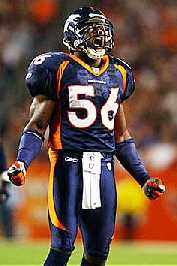
 Horse of a Different Color (1/3/04).
In each of the past three seasons, the Broncos have taken the field at least once wearing an alternate uniform. In 2001 it was the 1987 "Throwbacks" for the Thanksgiving Day game in Dallas (see 2001 detail) and in 2002, it was the orange mirror-image of the home jersey unveiled during the November 24th game versus the Indianapolis Colts (see 2002 detail).
Horse of a Different Color (1/3/04).
In each of the past three seasons, the Broncos have taken the field at least once wearing an alternate uniform. In 2001 it was the 1987 "Throwbacks" for the Thanksgiving Day game in Dallas (see 2001 detail) and in 2002, it was the orange mirror-image of the home jersey unveiled during the November 24th game versus the Indianapolis Colts (see 2002 detail).
For 2003, the team reached back to the 1997 exhibition season and revived the monochromatic look of the dark blue pants worn with the home jerseys. Debuting at the home opener (September 22nd versus the Raiders), the trousers reappeared for a second time on November 3rd (versus the Patriots).
For more detail and other uniform related news as covered by the Denver-area media, see the 2003 detail page.
Wearing the alternate dark pants, LB Al Wilson (left) celebrates after making a tackle during the 2003 season home opener (Sep 22nd vs. Oakland Raiders).
 Broncos’ Auction (Finally) Offering Game Jerseys (1/3/04).
In these days where a game-used jersey's provenance must be authenticated, verified and certified, the one sure way to feel comfortable with your acquisition is to go straight to the source. Beginning with the 2003 season, jersey collectors could do just that, obtaining game-used memorabilia directly from the Broncos.
Broncos’ Auction (Finally) Offering Game Jerseys (1/3/04).
In these days where a game-used jersey's provenance must be authenticated, verified and certified, the one sure way to feel comfortable with your acquisition is to go straight to the source. Beginning with the 2003 season, jersey collectors could do just that, obtaining game-used memorabilia directly from the Broncos.
In 2002, the Broncos became one of several NFL teams who started offering collectibles--primarily autographed items--provided by the team and its players via NFL Auctions on eBay. With proceeds benefiting the Denver Broncos Charity Fund , over 350 completed auctions since August of 2002 have raised nearly $65,000 for the organizations' charitable efforts.
In October of 2003, the Broncos began offering game-used jerseys worn by players in the current season's action, just weeks prior to the auction. Through the course of the regular season, a total of ten jerseys were auctioned from players including Kennoy Kennedy, Ashley Lelie, John Mobley, Deltha O'Neal, Clinton Portis, Rod Smith and Al Wilson. Winning bids ranged from a very affordable $243 for a Deltha O'Neal gamer to a high of $5,862 for Clinton Portis' shirt from the November 23rd game versus the Bears. Not including the mentioned extremes of the range, the average price was about $838 per jersey (for additional detail, see sales data in our transaction archive in Mircosoft Excel 97 (.xls) format).
 Odds 'n' Ends (9/6/03). With each new update, it is our intent to offer an article (or articles) that is timely, relevant, and substantial, so as to be of interest to both of the readers who follow this site on a regular basis. Alas, there are times when, even with four months to prepare and ponder, either nothing of real interest has taken place or, I've procrastinated too long and haven't the time to undertake the project/article that was intended… This is one of those times. With two great ideas on the back burner, I had decided to wait, confident that some newsworthy gem would effortlessly drop into my lap. Come late August, both great ideas remain at simmer, with no easy-pickings having found their way to me. As such, what follows are a collection of notable, but minor tidbits of information, that by themselves, would have never stood alone. Under the circumstances, however, they will have to stand together and pass for this episode's entry.
Odds 'n' Ends (9/6/03). With each new update, it is our intent to offer an article (or articles) that is timely, relevant, and substantial, so as to be of interest to both of the readers who follow this site on a regular basis. Alas, there are times when, even with four months to prepare and ponder, either nothing of real interest has taken place or, I've procrastinated too long and haven't the time to undertake the project/article that was intended… This is one of those times. With two great ideas on the back burner, I had decided to wait, confident that some newsworthy gem would effortlessly drop into my lap. Come late August, both great ideas remain at simmer, with no easy-pickings having found their way to me. As such, what follows are a collection of notable, but minor tidbits of information, that by themselves, would have never stood alone. Under the circumstances, however, they will have to stand together and pass for this episode's entry.
 On The Auction Block (5/5/03). As a prelude to the 2003 edition of summer camp, two auction houses are set to offer a number of Broncos lots that are sure to pique the interest (and possibly the scorn) of game-used/worn collectors.
Grey Flannel’s 2003 Summer Games auction is set to conclude May 21st and features three prominent Broncos items. The first (lot # 186) is a blue home jersey worn by future Hall of Fame quarterback John Elway during the teams’ first Super Bowl season campaign in 1997. Second up (lot # 187) is a game helmet worn by running back Terrell Davis in 1998 when “TD” helped lead the team to a second straight championship season with a 2,008-yard effort. Finally, up for bid is a white road jersey, worn by WR Rod Smith during the 2001 when he led the NFL with 113 receptions. Parties interested in these or any of the several hundred other lots can visit the web site at www. greyflannelauctions.com/. Two weeks thereafter, American Memorabilia concludes its’ auction on June 5th with four more significant items up for bid. First up is what is described as “Craig Morton Game Worn 1982 Final Denver Broncos Jersey”. This lot (#19), however, should be viewed with a good deal of skepticism as both the tagging as well as the style of the jersey itself would seem to indicate a much later vintage. For the underbidder from Grey Flannel’s auction, lot #66 features a John Elway game worn 1998 home jersey with Elway’s 1997 game worn helmet being offered in lot #149. Next up is what is being offered as Floyd Little’s game worn helmet from his rookie (1967) season. While the suspension helmet being offered may very well be one of Little’s there are some undisclosed inconsistencies. While the shell’s white center stripe would seem to indicate a ’67 vintage (the only year of the white center on the blue helmet), the presence of the “D” logos would suggest a later vintage as the logos did not appear on the Broncos’ blue helmets until 1968.
It should be noted that an attempt to contact American Memorabilia via e-mail regarding the discrepancies with the Morton jersey and Little helmet was unsuccessful as the link from their web site ( www.americanmemorabilia.com/) yielded an invalid e-mail address (given as AmericanMemorabili@hotmail.com). Also notable is that this is the second questionable Morton Broncos’ jersey to be offered at auction by the Las Vegas-based company (see “Players Not Always The Best Authenticators” article from 7/29/01 below).
On The Auction Block (5/5/03). As a prelude to the 2003 edition of summer camp, two auction houses are set to offer a number of Broncos lots that are sure to pique the interest (and possibly the scorn) of game-used/worn collectors.
Grey Flannel’s 2003 Summer Games auction is set to conclude May 21st and features three prominent Broncos items. The first (lot # 186) is a blue home jersey worn by future Hall of Fame quarterback John Elway during the teams’ first Super Bowl season campaign in 1997. Second up (lot # 187) is a game helmet worn by running back Terrell Davis in 1998 when “TD” helped lead the team to a second straight championship season with a 2,008-yard effort. Finally, up for bid is a white road jersey, worn by WR Rod Smith during the 2001 when he led the NFL with 113 receptions. Parties interested in these or any of the several hundred other lots can visit the web site at www. greyflannelauctions.com/. Two weeks thereafter, American Memorabilia concludes its’ auction on June 5th with four more significant items up for bid. First up is what is described as “Craig Morton Game Worn 1982 Final Denver Broncos Jersey”. This lot (#19), however, should be viewed with a good deal of skepticism as both the tagging as well as the style of the jersey itself would seem to indicate a much later vintage. For the underbidder from Grey Flannel’s auction, lot #66 features a John Elway game worn 1998 home jersey with Elway’s 1997 game worn helmet being offered in lot #149. Next up is what is being offered as Floyd Little’s game worn helmet from his rookie (1967) season. While the suspension helmet being offered may very well be one of Little’s there are some undisclosed inconsistencies. While the shell’s white center stripe would seem to indicate a ’67 vintage (the only year of the white center on the blue helmet), the presence of the “D” logos would suggest a later vintage as the logos did not appear on the Broncos’ blue helmets until 1968.
It should be noted that an attempt to contact American Memorabilia via e-mail regarding the discrepancies with the Morton jersey and Little helmet was unsuccessful as the link from their web site ( www.americanmemorabilia.com/) yielded an invalid e-mail address (given as AmericanMemorabili@hotmail.com). Also notable is that this is the second questionable Morton Broncos’ jersey to be offered at auction by the Las Vegas-based company (see “Players Not Always The Best Authenticators” article from 7/29/01 below).
 Broncos Re-Equip For '02 (12/30/02). For 2002, two new additions to the Broncos uniform stable were introduced... An alternate jersey/uniform and a new logo to identify "NFL Equipment".
Broncos Re-Equip For '02 (12/30/02). For 2002, two new additions to the Broncos uniform stable were introduced... An alternate jersey/uniform and a new logo to identify "NFL Equipment".
Most obvious was the introduction of the third "alternate" jersey that made its appearance on November 24th during the home game versus the Indianapolis Colts. Returning to a uniform that is without question, "predominantly orange," the jersey is, for the most part, a mirror image of their home jerseys, with the blue and orange color scheme reversed. The jersey are orange with white numbers and blue trim and were complimented by the team's normal road pants, which are white with blue and orange trim.
Beginning with the 2002 season, the NFL has initiated a program that allows teams to unveil a third jersey for wear during one home game over the next five years. In addition to Denver, six clubs have chosen to take advantage of the initiative for the inaugural year.
Another new initiative for 2002 was the introduction of the "NFL Equipment" logo. The Broncos, along with the leagues' 31 other teams, saw the new logo applied to jerseys, pants and other on-field apparel in place of the NFL shield which first appeared on jerseys in 1991. The new logo actually incorporates the NFL shield within a round-cornered inverted triangle field with the word "Equipment" arced over the shield.
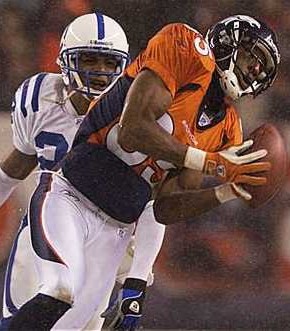
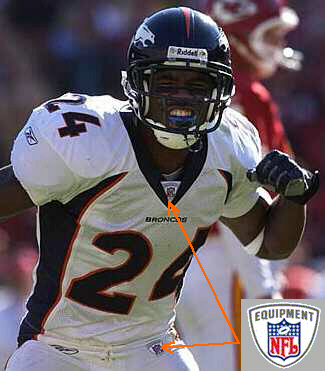
 Does Size Really Matter? (8/25/02). On occasion, you may find yourself in the midst of examining a jersey for evidence of wear, proper tagging, etc., only to get to the size tag and... "Whoa! I thought he wore a 44 and this is a 48! What's going on here?!?" Or when answering my e-mail... "What's the 'right' size for a Goldie Sellers jersey?" And my answer is, "Well, that depends."
Though size is a factor to be considered when examining a jersey, it is not a deal-killer when it comes to authentication. For a variety of reasons, a player may have worn more than one size through a career, season or even within the same game. Three primary factors may come into play when it comes to sizing variability.... Player geometry, weather, and supplier changes.
Changes in the size of a player and/or his padding can be one factor. Keith Traylor—who in 1992 was a 260-lbs. linebacker—more than likely wore a different sized jersey than in 2000, while playing as a 304-lbs. defensive tackle. And John Elway, who gained only 13 lbs. through a 17-year career, went from wearing size 42 to a size 46. Not to accommodate his expanding girth, but rather to accommodate ever bulkier rib/kidney padding.
Cold weather can also be a factor affecting a player's jersey size. In one instance, a team (the Chiefs) issued a total of 4 jerseys to each player on the roster-one each home and road in the player's "standard" size as well as one each home and road jersey up-sized by one size to accommodate the player's cold-weather under garments. A particular player may have suited up in one size jersey to start the game and at halftime, changed into a larger size as inclimate weather rolled in.
Finally, there can be significantly different cuts in size from one manufacturer to another. In comparing sized 46 Wilson an Nike jerseys side by side, there was a 2" difference in the armpit-to-armpit measurement… A 4" difference in actual chest size. As teams switched from one manufacturer to another, player's jersey sizes may have changed as well.
Does Size Really Matter? (8/25/02). On occasion, you may find yourself in the midst of examining a jersey for evidence of wear, proper tagging, etc., only to get to the size tag and... "Whoa! I thought he wore a 44 and this is a 48! What's going on here?!?" Or when answering my e-mail... "What's the 'right' size for a Goldie Sellers jersey?" And my answer is, "Well, that depends."
Though size is a factor to be considered when examining a jersey, it is not a deal-killer when it comes to authentication. For a variety of reasons, a player may have worn more than one size through a career, season or even within the same game. Three primary factors may come into play when it comes to sizing variability.... Player geometry, weather, and supplier changes.
Changes in the size of a player and/or his padding can be one factor. Keith Traylor—who in 1992 was a 260-lbs. linebacker—more than likely wore a different sized jersey than in 2000, while playing as a 304-lbs. defensive tackle. And John Elway, who gained only 13 lbs. through a 17-year career, went from wearing size 42 to a size 46. Not to accommodate his expanding girth, but rather to accommodate ever bulkier rib/kidney padding.
Cold weather can also be a factor affecting a player's jersey size. In one instance, a team (the Chiefs) issued a total of 4 jerseys to each player on the roster-one each home and road in the player's "standard" size as well as one each home and road jersey up-sized by one size to accommodate the player's cold-weather under garments. A particular player may have suited up in one size jersey to start the game and at halftime, changed into a larger size as inclimate weather rolled in.
Finally, there can be significantly different cuts in size from one manufacturer to another. In comparing sized 46 Wilson an Nike jerseys side by side, there was a 2" difference in the armpit-to-armpit measurement… A 4" difference in actual chest size. As teams switched from one manufacturer to another, player's jersey sizes may have changed as well.
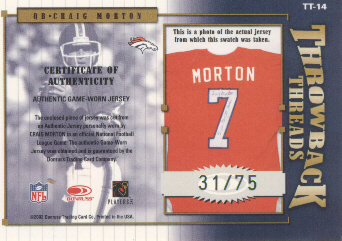
 UPDATE... Players Not Always the Best Authenticators (8/25/02). From our 3rd-quarter update last year, an article detailed how a misrepresented jersey wound up on the national auction circut "in the hands of some unsuspecting collector who has paid a premium" (See 7/29/01 article below).
We recently received a sample of the 2002 Donruss Elite Throwback Threads game-worn memorabilia card #TT-14 of quarterback Craig Morton. A caption above the photo on the back reads, "This is a photo of the actual jersey from which this swatch was taken." The photo depicts the same jersey as was sold at last year's American Memorabilia auction. While I don't feel nearly as sorry for the buyer who paid a premium, the downside is that the jersey is now in the hands of numerous unsuspecting collectors.
UPDATE... Players Not Always the Best Authenticators (8/25/02). From our 3rd-quarter update last year, an article detailed how a misrepresented jersey wound up on the national auction circut "in the hands of some unsuspecting collector who has paid a premium" (See 7/29/01 article below).
We recently received a sample of the 2002 Donruss Elite Throwback Threads game-worn memorabilia card #TT-14 of quarterback Craig Morton. A caption above the photo on the back reads, "This is a photo of the actual jersey from which this swatch was taken." The photo depicts the same jersey as was sold at last year's American Memorabilia auction. While I don't feel nearly as sorry for the buyer who paid a premium, the downside is that the jersey is now in the hands of numerous unsuspecting collectors.
 New Helmet Available (8/27/02). Described as "The first helmet using new technology, designed with the intent of reducing the risk of concussion", many players have been seen wearing the new Riddell Revolution helmet. For more information, see the Product Fact Sheet at the Riddell web site.
New Helmet Available (8/27/02). Described as "The first helmet using new technology, designed with the intent of reducing the risk of concussion", many players have been seen wearing the new Riddell Revolution helmet. For more information, see the Product Fact Sheet at the Riddell web site.
 Spring Cleaning Benefits Collectors/Fans (5/11/02). On Saturday, March 9th, the Broncos' held a garage sale of sorts, ridding the teams' closets (or lockers if you will) of clothing no longer needed. To the delight of Broncos' fans and collectors, the team placed their used 1997 through 2000 seasons' apparel up for public sale.
Held at the team's stadium gift shop, jerseys-both game-worn and team-issued-were available for $80, plus sales tax. A limited number of pants were also available ($50) as were other odds and end such as sideline capes and coaches' shirts.
One collector who attended the sale indicated that there were approximately 200 people who attended the one-day sale in hopes of acquiring one of the 300 or so jersey that were made available. Selection was on a first-come, first-served basis with fans lining up at the gift shop's doors well before the 9AM opening time. Without a limit, many shoppers purchased multiple pieces.
Several entrepreneurs wasted no time in brining some of these items to a broader market. By Sunday, March 10th, at least three different individuals or businesses had placed items purchased the day before up for sale on the eBay auction web site. Looking for a quick profit, most jerseys offered were listed with minimum bids ranging from $99 to over $200.
As would be expected, there were no star names in this lot. From the sample offered, most of the game-worn/used jerseys were from players well down the depth charts, active only on special teams play, if that. Some of the so-called "worn" items showed little or no wear whatsoever. Likewise, most of the team-issued pieces appeared to be early season issues for players who would never make the final cut and appear on the teams' roster for the year.
Many of the "no-name" jerseys failed to sell at even a slight premium over their $80 cost, while the majority of the better jerseys offered on eBay fetched an average price of $186. A few notable names included QB Jeff Brohm, TE Byron Chamberlain, RB Vaughn Hebron, WR Travis McGriff, DE Maa Tanuvasa and LB Nate Wayne.
Spring Cleaning Benefits Collectors/Fans (5/11/02). On Saturday, March 9th, the Broncos' held a garage sale of sorts, ridding the teams' closets (or lockers if you will) of clothing no longer needed. To the delight of Broncos' fans and collectors, the team placed their used 1997 through 2000 seasons' apparel up for public sale.
Held at the team's stadium gift shop, jerseys-both game-worn and team-issued-were available for $80, plus sales tax. A limited number of pants were also available ($50) as were other odds and end such as sideline capes and coaches' shirts.
One collector who attended the sale indicated that there were approximately 200 people who attended the one-day sale in hopes of acquiring one of the 300 or so jersey that were made available. Selection was on a first-come, first-served basis with fans lining up at the gift shop's doors well before the 9AM opening time. Without a limit, many shoppers purchased multiple pieces.
Several entrepreneurs wasted no time in brining some of these items to a broader market. By Sunday, March 10th, at least three different individuals or businesses had placed items purchased the day before up for sale on the eBay auction web site. Looking for a quick profit, most jerseys offered were listed with minimum bids ranging from $99 to over $200.
As would be expected, there were no star names in this lot. From the sample offered, most of the game-worn/used jerseys were from players well down the depth charts, active only on special teams play, if that. Some of the so-called "worn" items showed little or no wear whatsoever. Likewise, most of the team-issued pieces appeared to be early season issues for players who would never make the final cut and appear on the teams' roster for the year.
Many of the "no-name" jerseys failed to sell at even a slight premium over their $80 cost, while the majority of the better jerseys offered on eBay fetched an average price of $186. A few notable names included QB Jeff Brohm, TE Byron Chamberlain, RB Vaughn Hebron, WR Travis McGriff, DE Maa Tanuvasa and LB Nate Wayne.
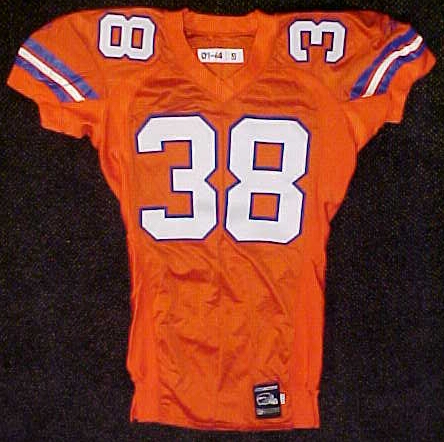
 Throwbacks Make A Return (1/1/02). The predominately orange Bronco uniforms of the late 1980s made a one-time return to the field this past Thanksgiving day when Denver suited up against the Cowboys in Irvin, Texas.
The Cowboys also took a step back in time donning the popular "Double Star" style jerseys, marking the first time that Denver has donned a "thowback" style uniform since 1994 (see the 1994 "Throwback" Jersey Detail Page).
Whereas the Broncos wore both a home and road version of the 1965-style uniforms for the NFL's 75th Anniversary season celebration, this year's 1987 Throwbacks were only to be seen in the home orange variation. Apparently, even this one appearance may have been one too many for team owner Pat Bowlen. According to Denver Post sports writer Adam Schefter, the team allowed each of the players to take home his uniform and helmet. "In other words, Bowlen never wanted to see them again."
Throwbacks Make A Return (1/1/02). The predominately orange Bronco uniforms of the late 1980s made a one-time return to the field this past Thanksgiving day when Denver suited up against the Cowboys in Irvin, Texas.
The Cowboys also took a step back in time donning the popular "Double Star" style jerseys, marking the first time that Denver has donned a "thowback" style uniform since 1994 (see the 1994 "Throwback" Jersey Detail Page).
Whereas the Broncos wore both a home and road version of the 1965-style uniforms for the NFL's 75th Anniversary season celebration, this year's 1987 Throwbacks were only to be seen in the home orange variation. Apparently, even this one appearance may have been one too many for team owner Pat Bowlen. According to Denver Post sports writer Adam Schefter, the team allowed each of the players to take home his uniform and helmet. "In other words, Bowlen never wanted to see them again."
 eBay/NFL's "Auction For America" Benefits Victims & Collectors (1/1/02). Shortly after the September 11th tragedy, the NFL, along with its member teams, joined eBay in its "Auction for America" campaign to benefit the victims of the terrorist attacks. The proceeds from these auctions are being donated to numerous charities on behalf of eBay and the donors of the auctioned items.
Broncos' fans and collectors of game-used memorabilia have also had the opportunity to add authentic from-the-field jerseys from the 2001 season to their collections with 11 different players' jerseys being publicly offered since October (See "Recent Transactions" below). According to a November 6th report in the Denver Rocky Mountain News, a total of 14 jerseys were forwarded to the NFL specifically for this event including two jerseys each from Brian Griese, Mike Anderson, Olandis Gary, Jason Elam, Al Wilson and Rod Smith; and one jersey each from Bill Romanowski and Deltha O'Neal. Other items for the event sent to the NFL by the Broncos include autographed footballs, mini helmets and shoes.
Through just the first month of the campaign, items donated by the Broncos had generated nearly $10,000 via eBay's auction site. The Broncos items have raised more donations than all but two other NFL teams (behind only the 49ers and Rams) with a game-worn Brian Griese jersey selling for $4,328 (the second highest priced item after a Rams' Marshall Faulk jersey at $6,501). An NFL spokesman indicated that his office has so many Broncos items in inventory, the team is likely to move into first place among their NFL rivals by the time the Auction for America closes later this month.
eBay/NFL's "Auction For America" Benefits Victims & Collectors (1/1/02). Shortly after the September 11th tragedy, the NFL, along with its member teams, joined eBay in its "Auction for America" campaign to benefit the victims of the terrorist attacks. The proceeds from these auctions are being donated to numerous charities on behalf of eBay and the donors of the auctioned items.
Broncos' fans and collectors of game-used memorabilia have also had the opportunity to add authentic from-the-field jerseys from the 2001 season to their collections with 11 different players' jerseys being publicly offered since October (See "Recent Transactions" below). According to a November 6th report in the Denver Rocky Mountain News, a total of 14 jerseys were forwarded to the NFL specifically for this event including two jerseys each from Brian Griese, Mike Anderson, Olandis Gary, Jason Elam, Al Wilson and Rod Smith; and one jersey each from Bill Romanowski and Deltha O'Neal. Other items for the event sent to the NFL by the Broncos include autographed footballs, mini helmets and shoes.
Through just the first month of the campaign, items donated by the Broncos had generated nearly $10,000 via eBay's auction site. The Broncos items have raised more donations than all but two other NFL teams (behind only the 49ers and Rams) with a game-worn Brian Griese jersey selling for $4,328 (the second highest priced item after a Rams' Marshall Faulk jersey at $6,501). An NFL spokesman indicated that his office has so many Broncos items in inventory, the team is likely to move into first place among their NFL rivals by the time the Auction for America closes later this month.
 In Honor of the Fallen (9/23/01).
In Honor of the Fallen (9/23/01).
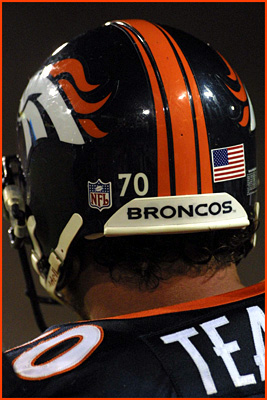 Following the tragic events of September 11th, the NFL (rightfully) postponed games scheduled the second week of the season (September 17th and 18th). Upon their return to the field on the 23rd, the Broncos, along with all other NFL teams, had the player's helmets adorned with a US flag. The decal was placed to the right side of the back of the helmet where, on the Broncos' helmets, the uniform number decal is usually present. On the modified helmets, the NFL shield logo has been displaced further to the (player's) left to provide room for the uniform number decal, which resides between the NFL shield logo and the center stripe (see photo at right).
Following the tragic events of September 11th, the NFL (rightfully) postponed games scheduled the second week of the season (September 17th and 18th). Upon their return to the field on the 23rd, the Broncos, along with all other NFL teams, had the player's helmets adorned with a US flag. The decal was placed to the right side of the back of the helmet where, on the Broncos' helmets, the uniform number decal is usually present. On the modified helmets, the NFL shield logo has been displaced further to the (player's) left to provide room for the uniform number decal, which resides between the NFL shield logo and the center stripe (see photo at right).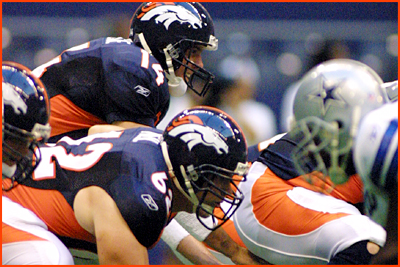 QB Brian Griese prepares to take first snap of 2001 in Reebok uniform.
QB Brian Griese prepares to take first snap of 2001 in Reebok uniform. Denver Dons Reebok Unis for 2001 (8/19/01). As originally reported in January (See Broncos to Don New Duds, 1/20/01 below), the Denver Broncos will take the field this year in uniforms manufactured by Reebok.
Denver Dons Reebok Unis for 2001 (8/19/01). As originally reported in January (See Broncos to Don New Duds, 1/20/01 below), the Denver Broncos will take the field this year in uniforms manufactured by Reebok. Players Not Always The Best Authenticators (7/29/01). Phil Wood's Uniforms column in the May 18th issue of Sports Collectors Digest pointed out to collectors that players aren't always the best sources of authenticity. Mr. Wood noted that "many players, if not most, pay little attention to the uniforms they wear. They know if it fits or not, and what team they're playing for, and the number (though sometimes memories fail on that as well), but as far as the manufacturer, tagging, trim, etc., ex-players are not particularly reliable." This should serve to remind both collectors and dealers alike that, in most cases, there are no irrefutable sources of authenticity.
Players Not Always The Best Authenticators (7/29/01). Phil Wood's Uniforms column in the May 18th issue of Sports Collectors Digest pointed out to collectors that players aren't always the best sources of authenticity. Mr. Wood noted that "many players, if not most, pay little attention to the uniforms they wear. They know if it fits or not, and what team they're playing for, and the number (though sometimes memories fail on that as well), but as far as the manufacturer, tagging, trim, etc., ex-players are not particularly reliable." This should serve to remind both collectors and dealers alike that, in most cases, there are no irrefutable sources of authenticity.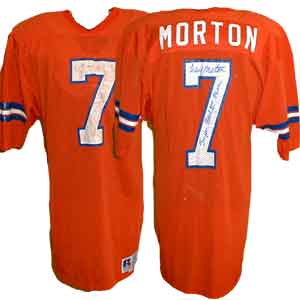 A case in point.... A recent major auction conducted by American Memorabilia included what was offered as "Craig Morton's Denver Broncos's Game Used Autographed Super Bowl XII Jersey." The auction catalog's description of the item stated, "Very difficult to obtain a game use (sic) jersey of this magnitude. Especially with provenance of this caliber. COA Craig Morton."
A case in point.... A recent major auction conducted by American Memorabilia included what was offered as "Craig Morton's Denver Broncos's Game Used Autographed Super Bowl XII Jersey." The auction catalog's description of the item stated, "Very difficult to obtain a game use (sic) jersey of this magnitude. Especially with provenance of this caliber. COA Craig Morton." The Broncos' Endzone Web Site Featured as "Site of the Week" in SCD (5/27/01). Our thanks to columnist Tom Kessenich who identified The Broncos' Endzone web site in the June 8, 2001 issue of Sports Collectors Digest as Site of the Week. The article in Mr. Kessenich's "Collecting on the Web" column (found on page 46) is transcribed as follows:
The Broncos' Endzone Web Site Featured as "Site of the Week" in SCD (5/27/01). Our thanks to columnist Tom Kessenich who identified The Broncos' Endzone web site in the June 8, 2001 issue of Sports Collectors Digest as Site of the Week. The article in Mr. Kessenich's "Collecting on the Web" column (found on page 46) is transcribed as follows: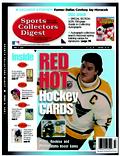 Few trends have captured collector's fancy in recent years quite like the game-worn craze. From game-worn jerseys to balls, bats football helmets and even towels, collectors can't seem to get enough items that they can find which at one time, were as close to the action as you're going to get.
Patrick Scoggin understands this mindset all too well. And he has created a Web site he hopes will not only satisfy fans of the Denver Broncos (which is the main focus of the site), but game-worn collectors as well.
Few trends have captured collector's fancy in recent years quite like the game-worn craze. From game-worn jerseys to balls, bats football helmets and even towels, collectors can't seem to get enough items that they can find which at one time, were as close to the action as you're going to get.
Patrick Scoggin understands this mindset all too well. And he has created a Web site he hopes will not only satisfy fans of the Denver Broncos (which is the main focus of the site), but game-worn collectors as well.The site ([now] located at endzone.pscoggin.com) is self-designed and maintained by Scoggin. It features numerous items of interest for Broncos and game-used collectors, such as general specifications for the team's jerseys from 1960 to present; detailed information for selected years and a beginner's guide to collecting game-used jerseys. There is also the Endzone's Marketplace where collectors can post free announcements to buy, sell, and/or trade Broncos' game-used/worn apparel and equipment, and Endzone's Game-Used News & Price Guide, featuring up-to-date information and pricing data.
"While the majority of our content is currently limited to our specific area of specialty (the Broncos), I hope to be able to expand the scope to include more detailed information of use to all collectors of the genre and/or specific detail related to other team's uniforms and jerseys," Scoggin said. "Any hope for expansion, however, is dependent upon the expertise and input from other collectors and dealers." Capturing the attention of collectors in a specific area is one way for a Web site to not only create a name for itself, but become an entity of interest in the hobby. By taking advantage of the wide amount of interest in game-used items, Scoggin's site has the potential to grow beyond its central area of focus and become a useful tool for collectors everywhere. Grey Flannel's 2001 Summer Games Auction Features Elway Items (4/28/01). Grey Flannel Auctions' 2001 Summer Games auction, scheduled for May 10th, includes two game used items attributed to former Broncos' quarterback and future Hall of Famer, John Elway.
Grey Flannel's 2001 Summer Games Auction Features Elway Items (4/28/01). Grey Flannel Auctions' 2001 Summer Games auction, scheduled for May 10th, includes two game used items attributed to former Broncos' quarterback and future Hall of Famer, John Elway. Broncos to Don New Duds (1/20/01). It would appear that, after a five-year run in Nike duds, the Broncos will switch to a new uniform supplier for the 2001 season and well beyond.
Broncos to Don New Duds (1/20/01). It would appear that, after a five-year run in Nike duds, the Broncos will switch to a new uniform supplier for the 2001 season and well beyond.
On December 19, 2000 the National Football League and Reebok International, Ltd. announced having reached an agreement to form an exclusive alliance. Under the terms of the deal, Reebok will become the exclusive rights holder to supply all 32 NFL teams' on-field uniforms and sideline apparel, practice apparel and headwear beginning in the 2002 NFL season. The ten-year agreement will run though the 2011 season. Additionally, the NFL will grant Reebok a 10-year exclusive license beginning in the 2002 NFL season to manufacture and sell NFL licensed merchandise including sideline apparel, footwear and an NFL-branded apparel line.
The deal was reviewed as part of the agenda at the recent NFL owner's meeting and it was indicated that "Reebok is expected to have 20 of the 31 teams ready to commit to its brand in time for the 2001 season (Associated Press, 1/17/01)."
While the Broncos were not specifically mentioned as one of the teams that will be added to the Reebok stable for 2001, it was indicated that "The Cowboys will be the only wearer of Nike equipment next season, while five teams will wear Adidas and five teams will wear Champion (ibid.)." As such, it can be assumed that the Broncos will be one of the 20 teams in Reebok uniforms for next season.
It's not known as to whether or not the change in manufacturers will be accompanied by any design changes. With the current Nike inspired "swoosh" design but 5 years old, any significant changes are unlikely.
 Grey Flannel's Fall Classic Auction Features 1-of-a-Kind Elway Jersey (11/27/00). Grey Flannel Auctions' 2nd Fall Classic auction, which concluded November 9th, included a one-of-a-kind game worn jersey of former Broncos' quarterback and future Hall of Famer, John Elway, the 1994 home (orange) "Thowback" jersey worn during the September 18th contest versus the division rival Raiders (lot #1188). When the hammer fell, the jersey reached a final sales price of $8,349 (including buyer's premium)... the second highest recorded price for an Elway gamer (record price of $10,186 established at Grey Flannel's Summer Games auction in June, 2000 for a '97 home jersey). Additional information on this style of jersey can also be found on our 1994 detail page.
Grey Flannel's Fall Classic Auction Features 1-of-a-Kind Elway Jersey (11/27/00). Grey Flannel Auctions' 2nd Fall Classic auction, which concluded November 9th, included a one-of-a-kind game worn jersey of former Broncos' quarterback and future Hall of Famer, John Elway, the 1994 home (orange) "Thowback" jersey worn during the September 18th contest versus the division rival Raiders (lot #1188). When the hammer fell, the jersey reached a final sales price of $8,349 (including buyer's premium)... the second highest recorded price for an Elway gamer (record price of $10,186 established at Grey Flannel's Summer Games auction in June, 2000 for a '97 home jersey). Additional information on this style of jersey can also be found on our 1994 detail page. COAs... Worth the Paper They're Written On? (05/28/00). One of the caveats often stressed to novice collectors is the value of Certificates of Authenticity (COAs). Our Beginner's Guide to Collecting Game-Used Jerseys notes that, "the COA... is nothing more than the opinion of the seller or authenticator...." A concept that even the more experienced collector must keep in mind. Even reputable dealers/authenticators can make mistakes and it is paramount that the buyer does his/her homework prior to plunking down their hard-earned greenbacks.
COAs... Worth the Paper They're Written On? (05/28/00). One of the caveats often stressed to novice collectors is the value of Certificates of Authenticity (COAs). Our Beginner's Guide to Collecting Game-Used Jerseys notes that, "the COA... is nothing more than the opinion of the seller or authenticator...." A concept that even the more experienced collector must keep in mind. Even reputable dealers/authenticators can make mistakes and it is paramount that the buyer does his/her homework prior to plunking down their hard-earned greenbacks.
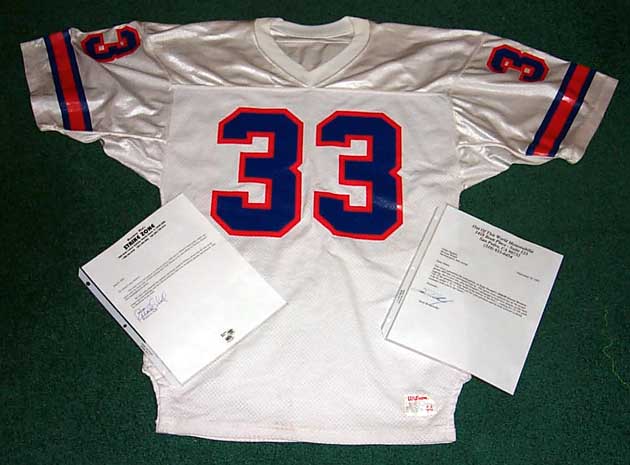 A case in point... An item offered on eBay was described as a 1988 Game Used/Worn Jersey of Tony Dorsett w/ autograph and 3 COA's including (two notable dealers listed w/ documents shown in photo). The photos that were posted with this listing, however, raised at least one eyebrow. As the image at the right shows this is clearly a Wilson jersey which was first used by the Broncos in 1989... Russell Athletic provided the teams' jerseys from the early 80s through 1988. Dorsett's last active year was 1988 as he spent the '89 season on IR, having sustained a knee injury prior to the beginning of the season. As Dorsett would have worn a Russell jersey in '88 and did not play once the team had converted to Wilson jerseys in '89, such an item would have to at least be viewed with a skeptical eye.
A case in point... An item offered on eBay was described as a 1988 Game Used/Worn Jersey of Tony Dorsett w/ autograph and 3 COA's including (two notable dealers listed w/ documents shown in photo). The photos that were posted with this listing, however, raised at least one eyebrow. As the image at the right shows this is clearly a Wilson jersey which was first used by the Broncos in 1989... Russell Athletic provided the teams' jerseys from the early 80s through 1988. Dorsett's last active year was 1988 as he spent the '89 season on IR, having sustained a knee injury prior to the beginning of the season. As Dorsett would have worn a Russell jersey in '88 and did not play once the team had converted to Wilson jerseys in '89, such an item would have to at least be viewed with a skeptical eye.
 Mystery Duds?!? One of the primary methods of research utilized by collectors of game-used equipment and apparel is the detailed examination of photographic images. Over the past several months, we have been examining photos from the mid-80s and came across a number of photos which have caused somewhat of a mystery.
Mystery Duds?!? One of the primary methods of research utilized by collectors of game-used equipment and apparel is the detailed examination of photographic images. Over the past several months, we have been examining photos from the mid-80s and came across a number of photos which have caused somewhat of a mystery.
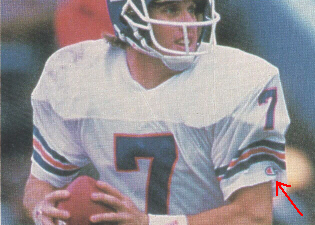
The photos in question are of quarterback John Elway, one of which (shown here) is from a 1986 promotional scratch-game card series of 24 Broncos players issued by area McDonald's restaurants. The source of the mystery as seen in the photo is a Champion manufacturer's logo which appears on the left sleeve between the striping and hem (as shown by red arrow). This occurrence is an oddity in that Bill Harpole, who was the team's equipment manager from 1983-'86 insisted that Russell Athletic was the Broncos' uniform supplier during his tenure and that, to the best of his knowledge, Champion was NEVER used as the team's supplier. Uniform expert Dave Miedema also pointed out in his Uniformity newsletter, "Also interesting is the style of the number 7 on Elway's jersey...not consistent with the normal, serif-bearing block numbers that Denver normally used in that era, but consistent with numbers on various other teams' Champion-supplied jerseys in the not-to-distant past."
Confronted with the McDonald’s photograph, Harpole suggested that, in spite of the live-action appearance of this photo, the photo was, more than likely, the product of a staged photo shoot. Further photographic evidence would, however, refute this assertion. A second live-action photo from the cover of the October 29, 1986 issue of The Sporting News also faintly shows Champion’s "C" logo on the left sleeve of Elway’s jersey.
Further investigation included a review of NFL Films’ Miraclemakers and Heartbreakers: The 1985 Denver Broncos and Mile High Champions: The 1986 Denver Broncos. During the 1985 season, Elway is wearing a white road jersey with sans serif-style numbering in road games at Kansas City (Nov. 27), Los Angeles (Nov 24) and Pittsburgh (Dec 1). A brief shot of Elway behind center in the Kansas City game also clearly depicts the Champion logo on the quarterback’s left sleeve. The 1986 video highlights of games at New York (Nov. 23) and Kansas City (Dec 7) also show Elway wearing a jersey with the sans serif style numerals, characteristic of the Champion style.
It should be noted that this anomaly has only been observed during the 1985 and '86 seasons, and only with the white, road jerseys. Also of note is that the use of the Champion jerseys seem to be limited to John Elway. Other players observed in the previously listed games all wear what appear to be Russell Athletic-style jerseys.
 Return to the (current) Game-Used News Page
Return to the (current) Game-Used News Page
 Go to The Endzone (Home Page)
Go to The Endzone (Home Page)
